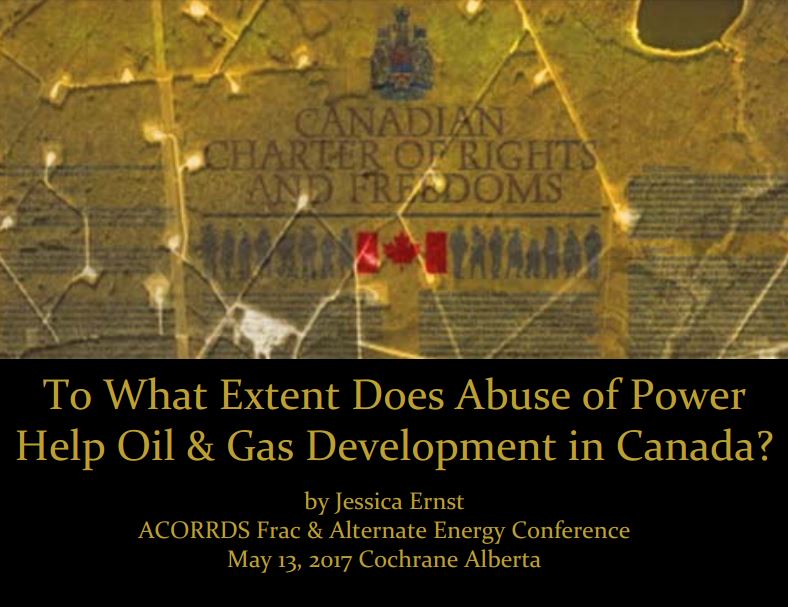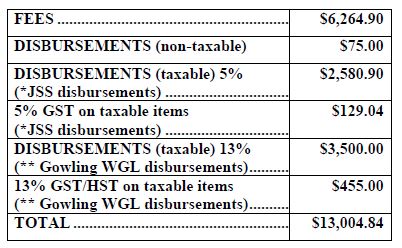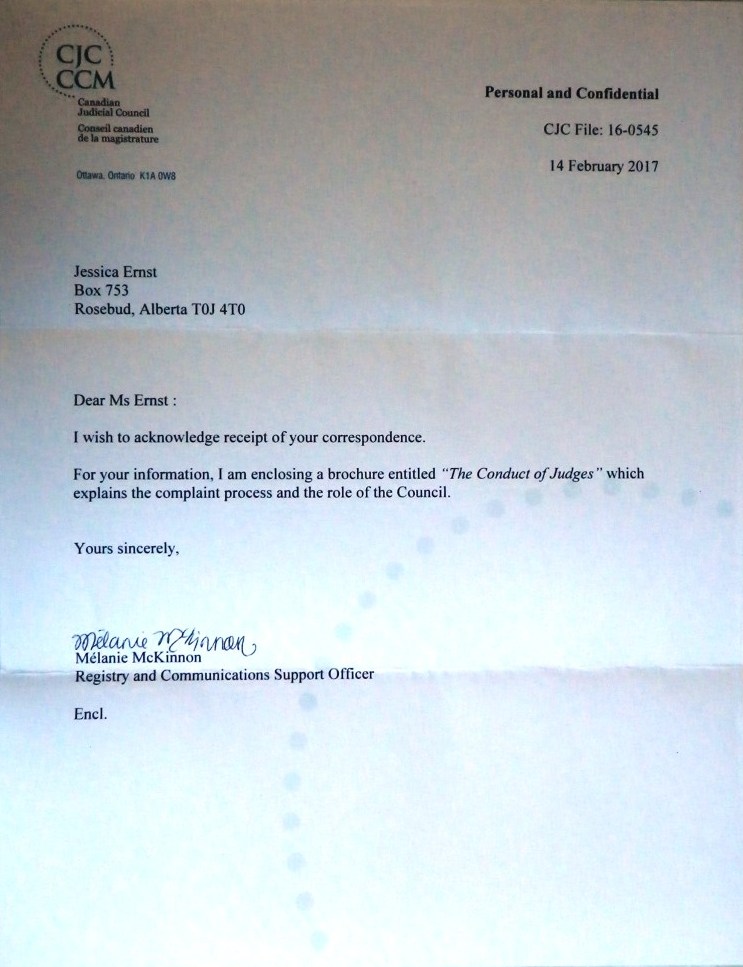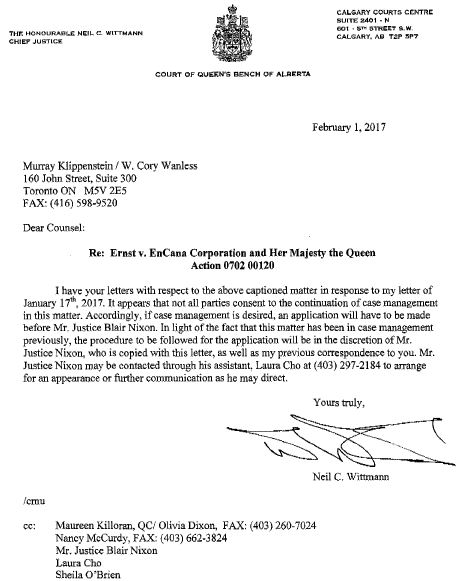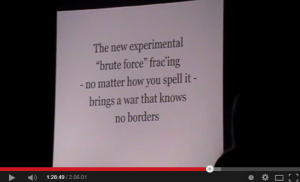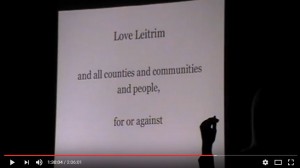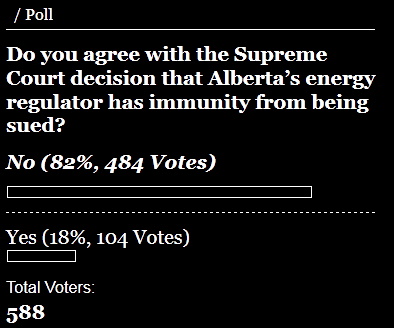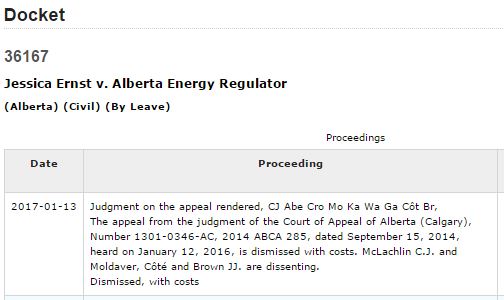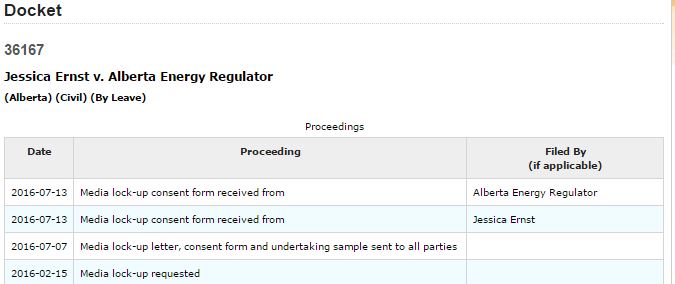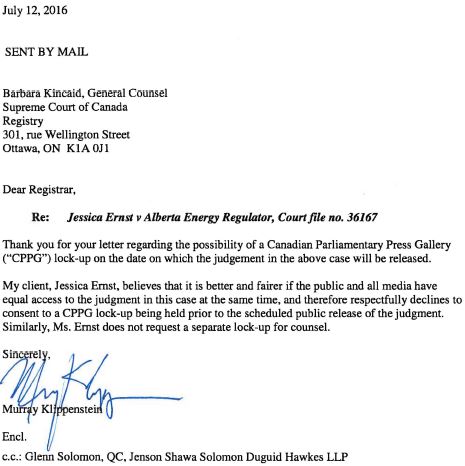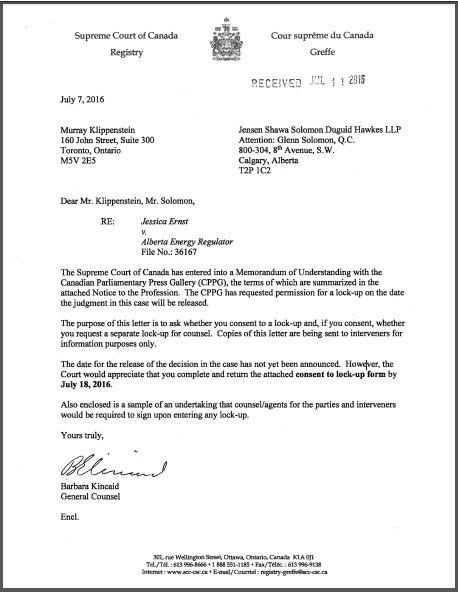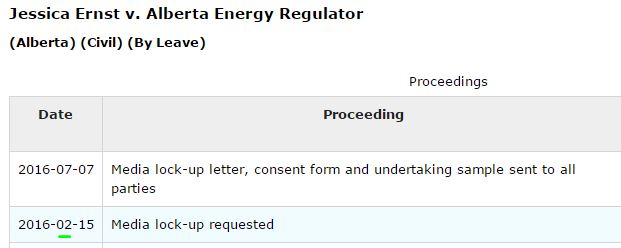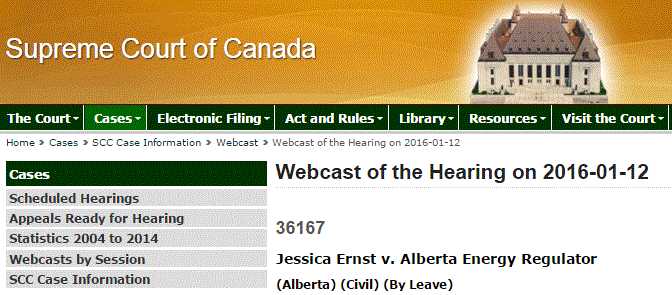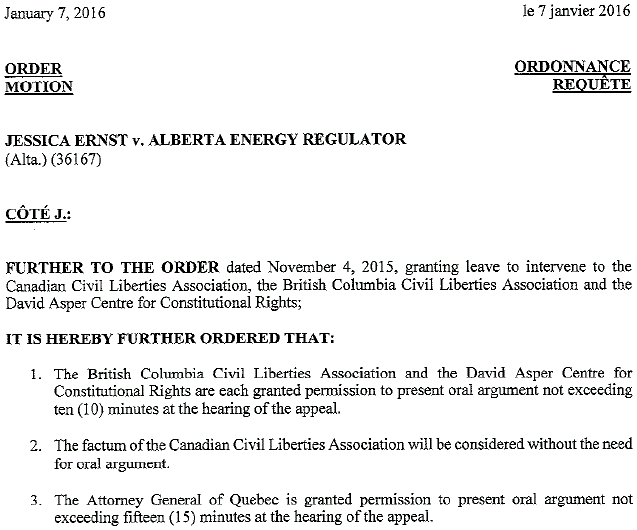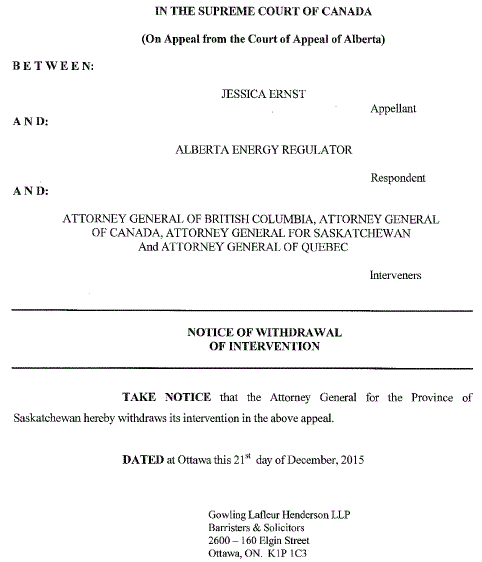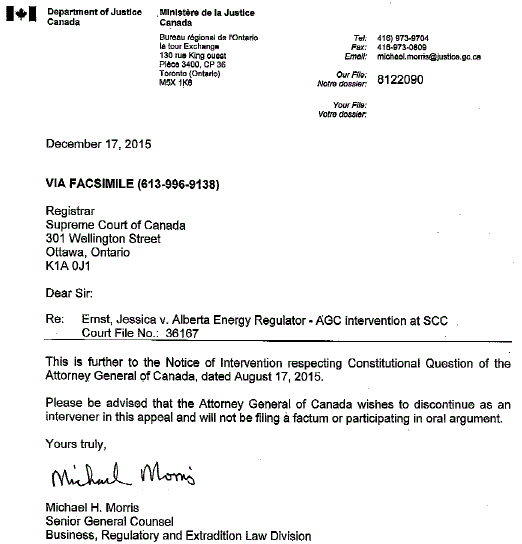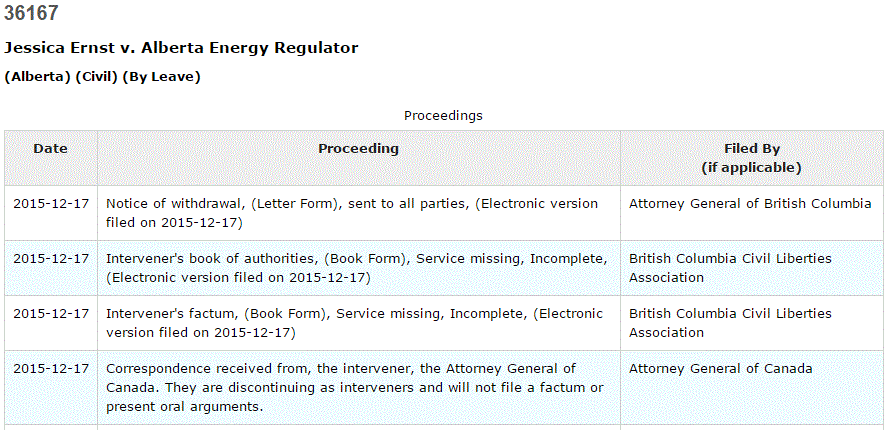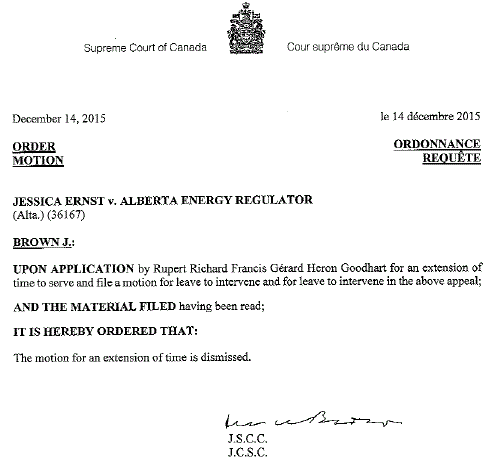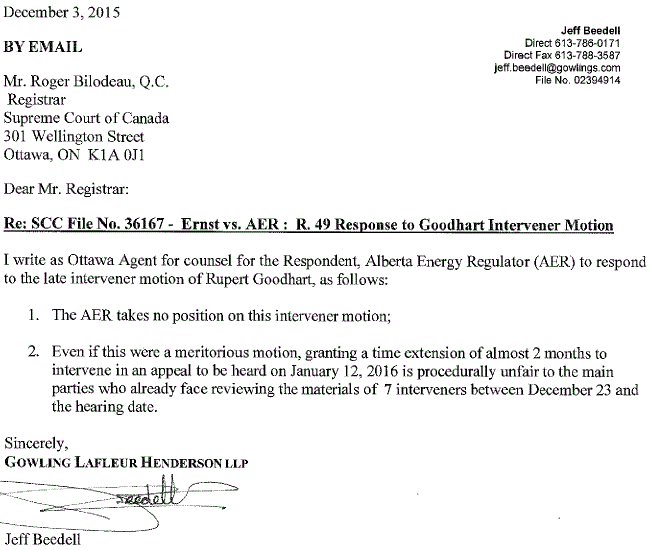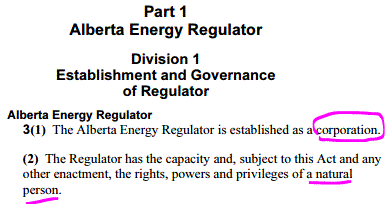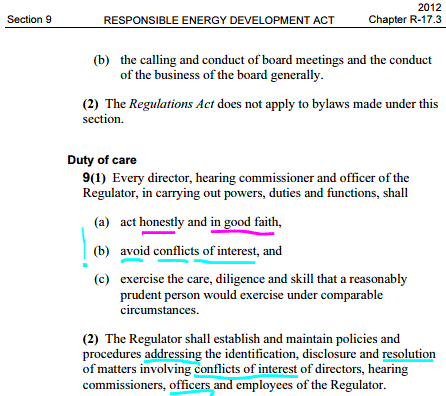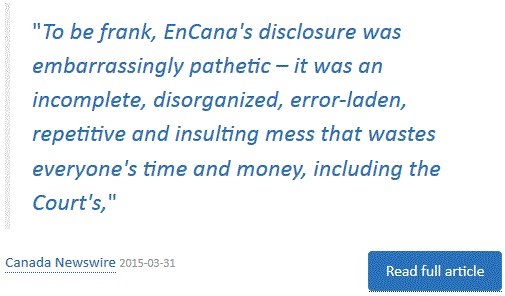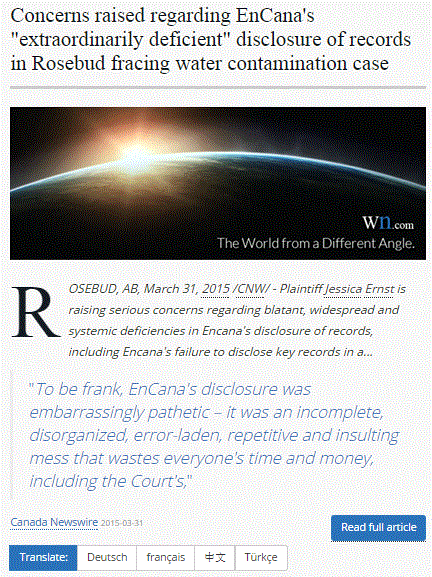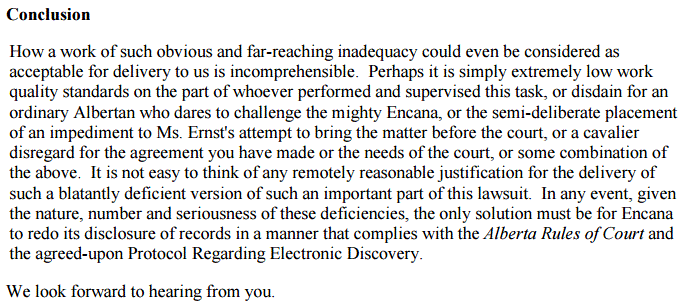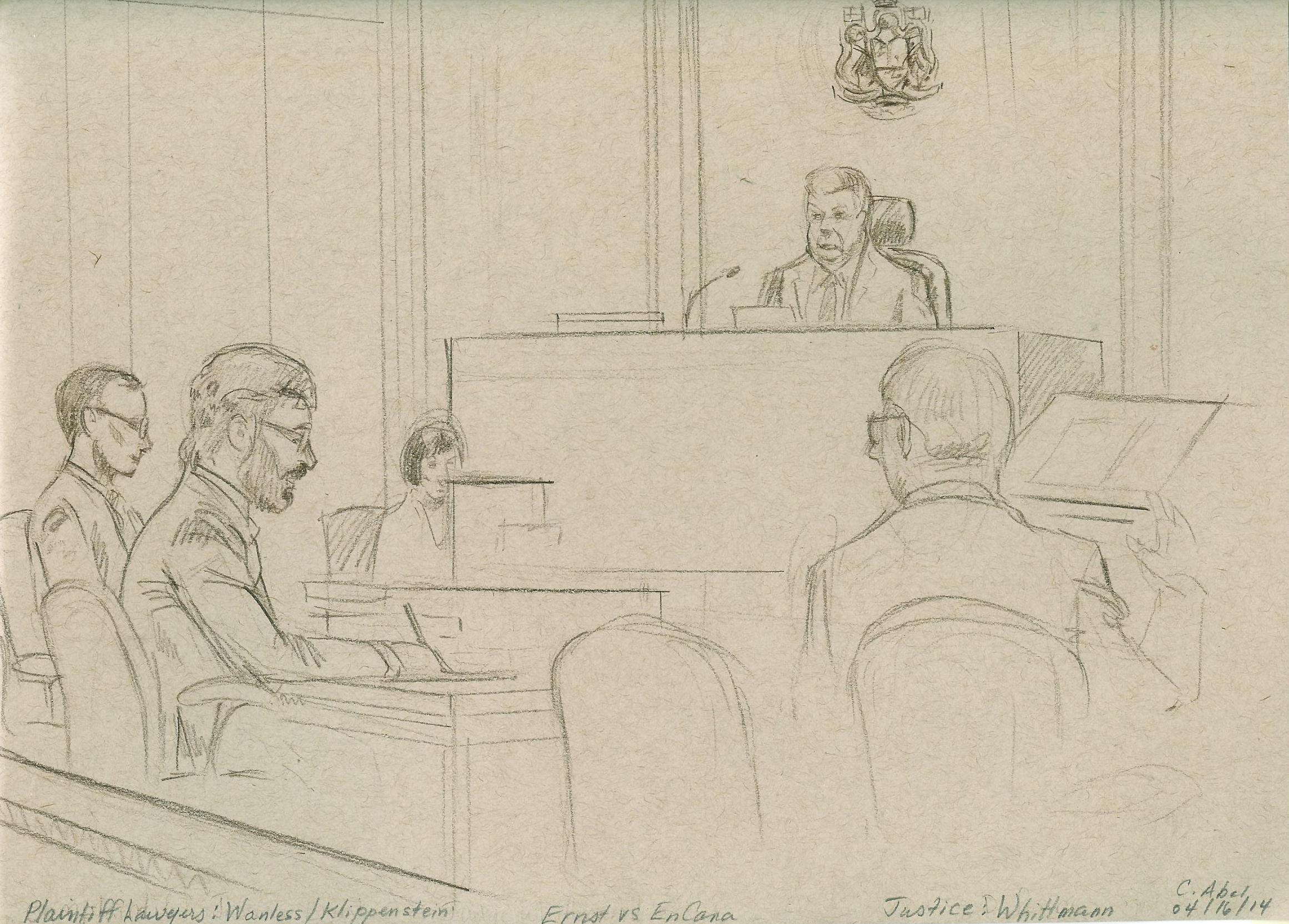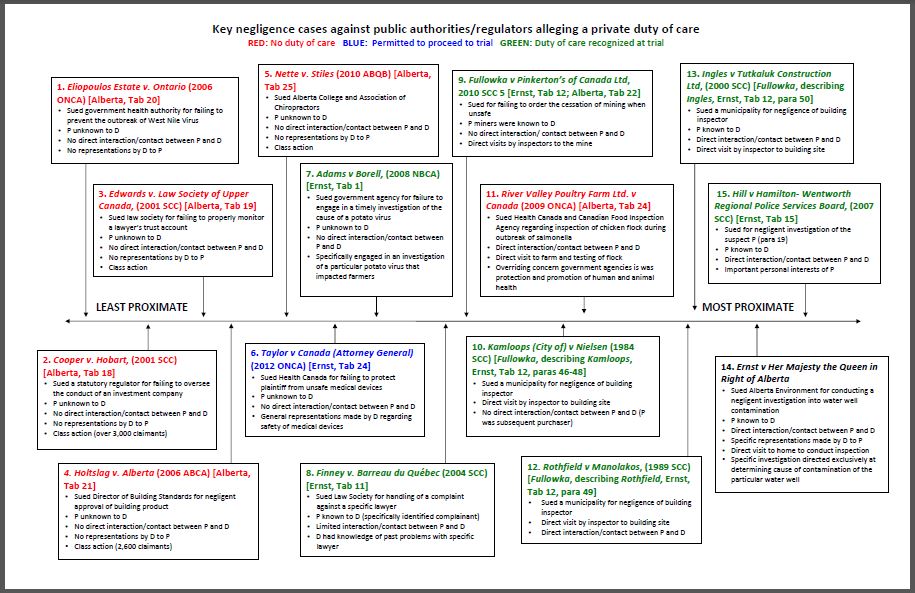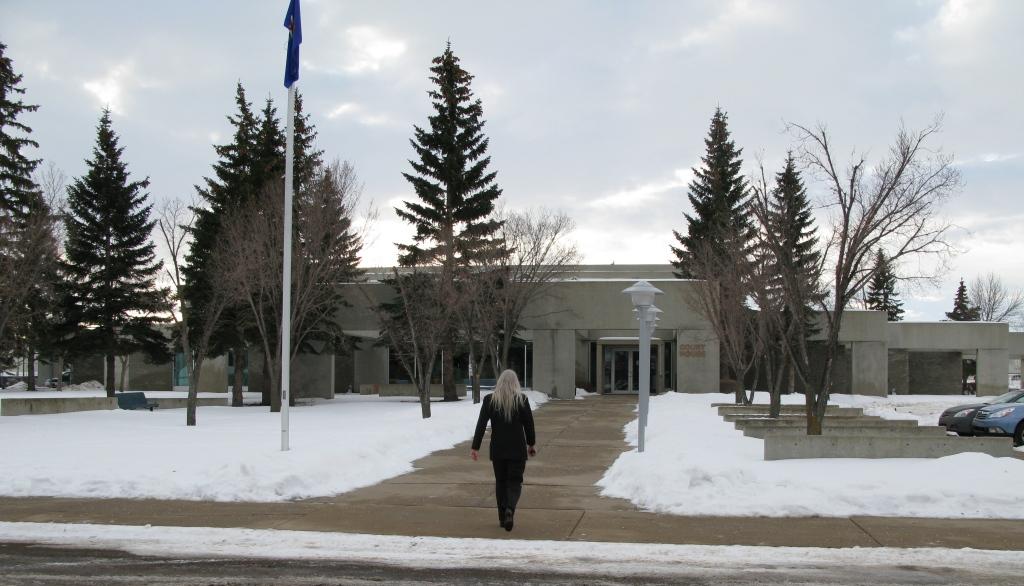The two most powerful warriors are patience and time.
Leo Tolstoy
Nikiforuk: The Brutal Legal Odyssey of Jessica Ernst Comes to an End
2021 04 01 (signed paper copy received April 29, 2021): J Eamon dismisses my lawsuit for long delay; orders my Jan 18, 2021 letter filed, supporting attachments sealed.
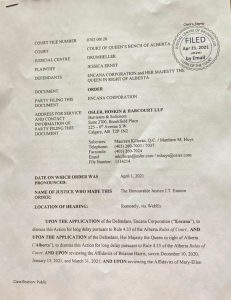
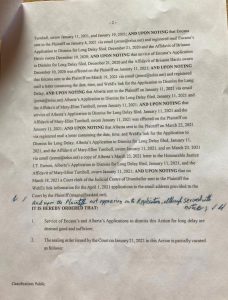
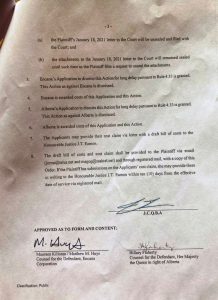
2021 01 18: My letter to J Eamon protesting my ex lead lawyer (he quit August 26, 2018) Murray Klippenstein misrepresenting me to the court
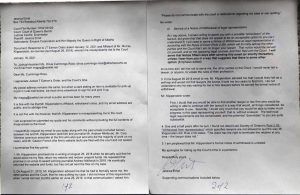
7021 01 11: In his Affidavit (sworn on Jan 11, 2021), Murray Klippenstein misrepresents me to the court, and copies the defendants. J Eamon ordered his Affidavit filed but sealed.
2020 12 30: After Encana filed application asking for my lawsuit to be dismissed for long delay, Murray Klippenstein (he quit August 26, 2018) served me his (undated) formal notice of quitting, 1.5 years after he advised me in writing in August 2019 he would do so in “fifteen days.”
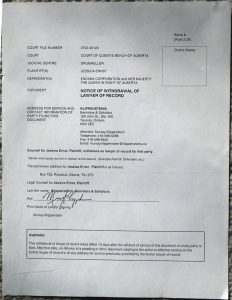
2019 08 26: Precisely a year after Murray Klippenstein and Cory Wanless abruptly quit the lawsuit (by email), I finally received my trust account funds of $40,000.00.
Four years (as of August 18, 2022): I waited! I have not yet received my files from Klippenstein or Wanless which I needed to continue my lawsuit and which I was repeatedly promised (in writing) would be sent to me after they quit in August 2018. Did they deliberately work to destroy my lawsuit to punish me for refusing to let Klippensteins gag me which I told the firm in 2007 I would never do (because protecting the public interest – drinking water – is too important and I will not give up my Charter right to Freedom of Expression), or because I went public with them quitt1ng? The stress has been intolerable.
There is no greater fraud than a promise not kept.
Scottish proverb
The lawyers did not quit the Choc vs Hudbay case which they took on years after taking on my case and for more than two years after quitting my case, they continued to claim on their website that they represented me. The firm only removed my case from their website after I publicly posted their dishonesty here; they did not specify they betrayed the public interest, my case and me – which their future and current clients need to know.
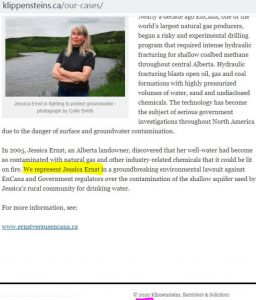
And Klippensteins did not quit the G20 class-action, taken on years after taking on my case. How many others did they not quit and or take on/try to take on after taking on mine?
Law Society Ontario Rule 2.09, withdrawal from representation:
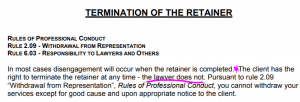
2019 08 10: Many thanks to those asking how they can make donations. A vital trust has been violated by Klippensteins: quitting; lying; ignoring correspondence; withholding my website about a year; not returning my files or trust account funds (includes donations sent to the law firm from kind citizens around the world). Under the circumstances, I think it’s inappropriate to ask for donations, so I removed the donate page.
***
Mrs Linde Turner, Drumheller AB
30 July 2019
Mr Murray Klippenstein
Klippensteins, Barristers & Solicitors
160 John Street, Suite 300
Toronto ON M5V 2E5
Dear Mr Klippenstein:
I met you several times during the 12 years of your representation of Ms Jessica Ernst of Rosebud in Alberta. I am now wondering about your withdrawal from her case after so many years as her lawyer, and so many hundreds of thousands of dollars. Your notice of withdrawal was on 26 August 2018, but she informs me that it is at present incomplete in terms of accounting, documentation, and financial return of the trust account.
The trust account of $40,000 is a very significant amount of money, especially to Ms Ernst – who is no longer able to work in her profession.
I consulted the Law Society of Ontario’s Practice Management Guidelines for Client Service and Communication, Section 2.18 Withdrawal of Services, or Otherwise Ending the Engagement. There are many references to the Rules of Professional Conduct Section 3.7 which clearly describe the obligations of a lawyer. You do not appear to have followed most. Do you intend to do so in a timely fashion?
While you claim to have minimized your office staff, it appears the physical office still exists, and you have not given up your accreditation as a lawyer in Ontario. It would therefore appear that you have obligations of some urgency to fulfill for Ms Ernst.
Your prompt attention would be appreciated by many of us who have followed her case and her website.
Yours truly,
Linde Turner
CC The Law Society of Ontario
Ms Natasha Hassan, Opinion Editor, The Globe and Mail
Mr Ossie Sheddy, Editor, The Drumheller Mail
Mr Jacques Gallant, Legal Affairs Reporter, Toronto Star
Mr Andrew Nikiforuk, Investigative Journalist
Ms Jessica Ernst
Canadian Lawyer Magazine: The profession’s dirty little secret
… David Debenham, a partner with McMillan LLP in Ottawa who is a certified fraud specialist and investigator, estimates only one in 10 frauds within the profession come to light. “A lot of firms that had lawyers, or law clerks, or staff that commit fraud tend to indemnify clients and not report it — it’s sort of the [profession’s] dirty little secret,” says Debenham, who is also a certified management accountant often hired by law firms to conduct fraud probes. He says there is no doubt the number of misappropriation cases is growing exponentially. …

2019 07 01: Happy KKKanada Day! The news about Klippensteins Law Firm quitting my lawsuit last August was added here this day.
2019 06 12: What Fresh Hell is This! Ernst reads in the media the real reason Mr. Murray Klippenstein quit her lawsuit. Ernst takes back her well wishes sent earlier – she wants Mr. Klippenstein to fail in his Stop SOP endeavors. Stop SOP is about power and how to keep it. (SOP = Statement of Principles.)
2018 08 29: Ernst letter to Mr. Murray Klippenstein:
Thank you for your August 26, 2018 email informing me that you and Mr. Cory Wanless will no longer represent me in my lawsuit. I am sorry that you think political changes in Ontario’s legal profession are incompatible with the operation of your firm and that you are dismantling it. …
I have always appreciated the frank advice you gave me from the start. Before you took on my case you warned me that I would likely walk down the street with nothing, financially bankrupt, even if I win, because of how unfair Canada’s legal system is for ordinary citizens. …
I wish you and Cory the best of success in your new endeavours.
2018 08 26: Ernst’s lead lawyer Mr. Klippenstein, without warning, via email, quit the lawsuit, blaming “some pretty substantial changes in the political climate in the legal profession in Ontario” and Ernst for no longer* having faith in Canada’s legal system.
Mr. Klippenstein wrote in his email that he would return Ernst’s trust account funds of about $40,000.00 and her files.
*Ernst studied Canada’s legal system long before contacting Klippensteins Law Firm. She knew she would not see “justice” from the system and would only be punished by the establishment (including judges) for seeking it. She told Mr. Klippenstein so when he warned her how unfair the system is.
Ernst endures her lawsuit for drinking water and to expose the truth about the law violations by Encana, Alberta Energy Regulator (AER) and Alberta Environment (the Alberta government). She knows she will lose a lot of money by doing it.
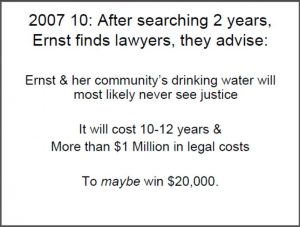
2019 is year 12.
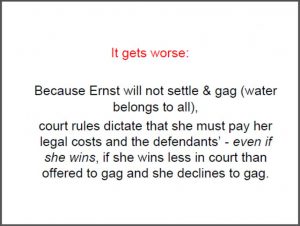
Canada’s legal & judicial industry pimps gag orders for obvious reasons.
AER’s outside counsel, Glenn Solomon (white text), explains to another frac’d Albertan (orange text) how the oil and gas industry gets away with polluting drinking water using gag orders so as to do it again “down the street.”
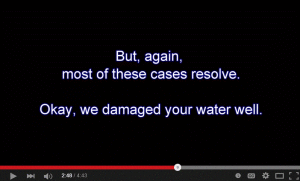
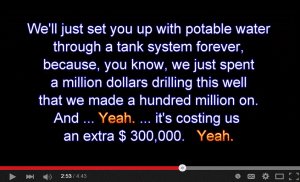
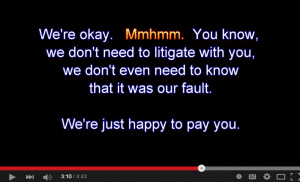
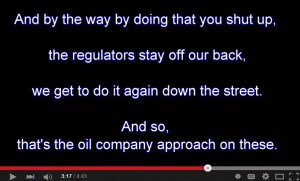
Listen to Glenn Solomon’s take the money and shut up advice.
If the legal industry truly serves the public interest, gag orders on pollution and water contamination by corporations must be made illegal.
Slides above from Ernst’s 2017 UK speaking tour
(Apologies for taking so long to post this August 2018 news. It has been an arduous battle getting my website from the law firm.)
***

The court is most merciful when the accused is most rich.
Proverb
2019 03 29: Nearly five years Ernst has waited for Encana to heed Justice Wittmann’s July 2014 Order to file all important and relevant documents with her:
Chemicals illegally injected repeatedly by Encana directly into Rosebud’s drinking water aquifers (on the company’s two most shallow frac’d gas wells in the community) remain secret, contrary to Alberta’s Rules of Court;
Encana has not filed with Ernst appropriately and completely cleaned up records for document exchange (the company’s “cleaned up” records are a worse and more disrespectful mess than the company’s first filing). Chemicals injected into Rosebud’s drinking water aquifers are required to be disclosed to Ernst under Alberta’s Rules of Court, including all trade secrets;
Encana has still not disclosed all chemicals the company secretly injected into hundreds of other gas wells in various formations in fresh water zones around Rosebud and all drilling, cementing, perforating and frac’ing details on these extremely shallow gas wells remain completely withheld;
Numerous other important and relevant documents remain withheld.
2018 04 06: Osgoode Hall Charter Conference panel on Ernst vs AER SCC Ruling: “Ernst: a puzzle.”
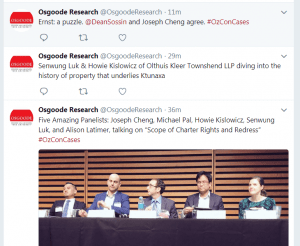
Snap of tweet from Osgoode Research and retweeted by Dean Sossin
2017 06 08 (post marked): Condescending letter from Canada Judicial Council to Ernst: SCC Justices making stuff up in published rulings is not ‘conduct’ and won’t be reviewed, in essence, saying it’s OK for judges to lie, as long as the lies are in rulings
Canadian Judicial Catch-22:
“The only body competent to amend or review reasons for decisions is the Court itself, in this case the Supreme Court of Canada.”
After taking a year and a day to rule on merely a simple preliminary matter, are the 9 Supreme Court Justices going to review themselves knowingly publishing lies, defaming Ernst?
Isn’t it fascinating that the “Judicial” Council “misplaced” Ernst’s letter to Chief Justice Beverly McLachlin for such a long time? Why did they suddenly look for and find it?
2019 07 09: Three Leaves to Appeal the Claimed Jurisdiction of Court of Queen’s Bench Over Vexatious Litigants by Jonnette Watson Hamilton:
… For one thing, the litigant has been characterized as a “vexatious litigant” by a person in authority. Their reputation and credibility have been, or can be perceived by the litigant or others to have been, damaged. A vexatious litigant starts out with at least one strike against them….
[Abella lied in her ruling – which the court knowingly published and sent to the media – writing that the AER found Ernst to be a “vexatious litigant” when there is documented evidence proving AER judged Ernst to be a criminal, then, terrorist, all without any charges, fingerprinting, evidence, hearing or trial. No regulator has found Ernst to be a vexatious litigant.]
Click to watch Ernst’s presentation
2017 05 08: Drinking water protector? Her Majesty the Queen in Right of Alberta (“Alberta Environment”) doesn’t even tell the truth in their Statement of Defence!
A few paragraphs from Ernst’s reply to Alberta Environment’s Statement of Defence:
2. Unless otherwise stated in this Reply. the Plaintiff denies every fact the Defendant Her Majesty the Queen in Right of Alberta (“Alberta Environment”) has stated in its Statement of Defence, and puts Alberta Environment to the strict proof thereof.
[Encana didn’t tell the truth in their Statement of Defence either]
3. In reply to paragraph 10 of the Statement of Defence of Alberta Environment, and in particular, Alberta Environment’s denial that it made “any specific representations to the Plaintiff’, the Plaintiff pleads and relies on paragraphs 63 and 64 of the Fresh Statement of Claim, and further pleads the following particulars:
a. In 2005, Alberta Environment Manager Nga de Ia Cruz represented to Ms. Ernst that the Alberta Environmental Guidelines for Groundwater Diversion for Coalbed Methane/Natural Gas in Coal Development, April 2004 and the Water Act were strictly enforced, notably in relation to any CBM developments. Ms. de la Cruz sent Ms. Ernst a link to the Alberta Environmental Guidelines, which specifically state:
Mitigation
Conditions also require the authorization holder to investigate and resolve any allegations of impact on any existing water supply. Measures to resolve any impact may include lowering the pump, deepening the impacted well, providing water supply to the well owner for his current water needs, and drilling a new water well. [Emphasis added].
b. On February 28, 2006, the Honourable Ralph Klein, the then Premier of Alberta, committed to intervening on behalf of Ms. Ernst and others. He gave his personal guarantee that the concerns of Ms. Ernst and others would be addressed, stating “I am willing to extend that to the fullest extent. Whatever is necessary to be done, will be done.”
c. On or around February 28, 2006, in a debate in the Legislative Assembly of Alberta, the then Alberta Environment Minister the Honourable Guy Boutilier stated:
Mr. Speaker, let me reiterate to the hon. member and to the families
[specifically including Ms. Ernst] that are here today: it is a very serious issue.
As Alberta Environment [sic] I will use every fibre of energy in my body to
assist this family relative to safe drinking water now and into the future. . . . I
can assure you that we are working with them and we will continue to work
with them because this is a very important issue to this family and to many
other families that have been impacted, be it by the natural flow or because of
what is being asserted relative to what is taking place in the water supply. . .
I’m using my energy to get these people safe drinking water. We will do
everything in our power to get them that, and then we can come to conclusive
evidence in terms of: is it naturally flowing, or is it the result of drilling? I don’t have that answer as of yet, btit it’s a very important question that we are
committed to getting the answer to very quickly….
d. On March 3, 2006, Alberta Environment employees, Darren Bourget (inspector), Al Straus (water tester), and Leslie Miller (trainee) met with Ms. Ernst at her property to test her contaminated water. During this meeting, Alberta Environment employees promised that Alberta Environment would provide permanent deliveries of safe alternate water to Ms. Ernst and her neighbours, and promised to conduct water testing on the municipal water wells that belong to Wheatland Country and that supply the Hamlet of Rosebud with drinking water. This representation was in addition to an earlier representation made by Mr. Bourget that Alberta Environment was going to supply Ms. Ernst with water tanks and start deliveries as soon as the water tanks were installed.
e. On March 6, 2006, Environment Minister Boutilier and Deputy Minister of the
Environment, C. Peter Watson, met with Ms. Ernst and others to discuss their water contamination concerns. During this meeting, the Minister promised an investigation into what was causing the contamination, and agreed to deliver safe water to Ms. Ernst’s home.
f. On or around April 24, 2006, Lestie Miller, a staff member at Alberta Environment, wrote to Ms. Ernst stating that “Alberta Environment is committed to responding to your concerns about the potential impacts of CBM activities on local aquifers.”
g. On June 20, 2006, Minister Boutilier wrote in a letter to Ms. Ernst that “[w]e have been working with you and several other landowners across the Province to
determine the sources of methane or gas in private water wells, and to ensure all
Albertans have access to safe, secure drinking water.” The letter goes on to say, in
relation to a similar water contamination complaint. “I assure you. if we do find any contraventions under our strict guidelines, action will be taken.”
h. On March 8, 2007, the Deputy Minister of the Environment, C. Peter Watson, wrote to Ms. Ernst, “Alberta Environment is committed to working with landowners concerned about their water supply.”
i. Throughout the material time, Ms. Ernst and her neighbours continued to request that Alberta Environment conduct a responsible and comprehensive investigation of the water contamination cases in the Rosebud area. In particular, Ms. Ernst and her neighbours specifically requested that Alberta Environment sample, test and investigate CBM gas wells to determine if they had caused the contamination to groundwater supplies in the Rosebud area. On April 19, 2007, Deputy Minister Watson wrote to Ms. Ernst to offer her and two of her neighbours “the comprehensive sampling you have requested.” Mr. Watson wrote that this sampling would ensure that Alberta Environment is “better able to respond to your concerns and any groundwater impacts in Rosebud and Redland.”
j. On April 17, 2008, the Minister of Environment the Honourable Rob Renner stated in the Legislative Assembly of Alberta in response to specific questions regarding water contamination in the Rosebud area, “Mr. Speaker, the issue of safe
groundwater is a priority for Alberta Environment. . . . [W]e [the Government of
Alberta] have the responsibility to ensure that the groundwater that Albertans access is safe.”
2017 04 24 (paper copy to Ernst received April 28, 2017): Letter from Mrs Linde Turner, Drumheller, to Honourable Beverley McLachlin, Chief Justice of Canada, c/o Canadian Judicial Council, Ottawa ON K1A 0W8
Dear Chief Justice McLachlin:
Re: Ernst vs AER, Supreme Court Judgment January 13, 2017
I am a retired librarian who has waited several months to write this letter, because I was so disappointed in this judgment.
The Supreme Court of Canada took one year to release the Court’s decision in this case. It is a great puzzle to me that, after all that time, the majority decision did not address directly the case submitted, which I understand was about the Canadian Charter of Rights and Freedoms.
Another puzzle is the statement that Ernst should have pressed the Alberta Courts for a Judicial Review. Despite a year to consider the case, no-one on the Supreme Court of Canada seems to have checked this: apparently no such remedy exists in Alberta law for what the AER did to Ernst.
Puzzle #3 is the rationale for Justice Abella’s unfounded accusation that Ernst was a “vexatious litigant”.
Ms Ernst lost her appeal, but the Supreme Court of Canada lost more. The Canadian Charter of Rights and Freedoms didn’t come out very well this time, it appeared rather hollow in the highest court of our land.
Yours sincerely,
Linde Turner
Cc Ms Jessica Ernst
***
The law shall be considered as always speaking, and where a matter or thing is expressed in the present tense, it shall be applied to the circumstances as they arise, so that effect may be given to the enactment according to its true spirit, intent and meaning.
– Canada’s Federal Interpretation Act’s section 10
***
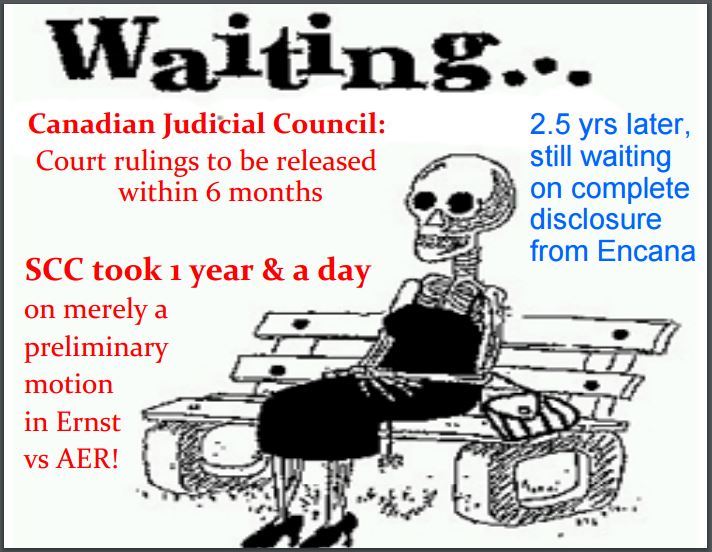
Slide from Ernst presentation at ACORRDS frac conference, Cochrane Alberta
2017 04 04: How many years will it take for Encana to heed Alberta’s Rules of Court and respect the parties’ 2014 agreed-upon Protocol for Electronic Discovery?
Case “Management” Alberta Style!
Klippenstein’s April 4, 2017 letter to Encana’s lawyer, Maureen Killoran with Osler, on the company still not having filed with Ernst appropriate records for discovery that heed Alberta’s Rules of Court and the agreed-upon Protocol for Electronic Discovery (that cost Ernst significant funds negotiating with Encana to reach agreement on in 2014).
Deadline for Encana’s filing was ordered by Chief Justice Neil Wittmann to be no later than December 19, 2014. From the letter:
I am writing regarding your letter of May 4, 2015 and my letter of March 27, 2015. We have waited nearly two years now and still have not been provided with any of the promised updated .csv format List of Records, or updates of the pdf’s of the records themselves and remain waiting for a satisfactory response to the other concerns raised.
In my letter, I raised serious concerns regarding Encana’s failure to meet its legal obligations regarding the disclosure of records in this action. I understood from your letter that we would shortly expect both an updated .csv format List of Records, and updates of the pdf’s of the records themselves. We have heard nothing further from you.
…
As stated in the conclusion of my letter of March 27, 2015, given the nature, number and seriousness of these deficiencies, the only solution must be for Encana to redo its disclosure of records in a manner that complies with the Alberta Rules of Court and the agreed-upon Protocol Regarding Electronic Discovery. If we do not receive the complete, cleaned-up and appropriate disclosure of records by May 30, 2017 in a manner that complies with both Encana’s obligations under the Alberta Rules of Court and the protocol agreed upon between the parties, my client will bring an application for a further and better affidavit of records. I note that Encana has already had more than two years to provide an appropriate response to our serious concerns regarding Encana’s affidavit of records, and has to date failed to do so. [Emphasis added]
VERY BAD NEWS (the bad news keep piling up): 2017 03 20: Case Management to continue against Ernst: “If at any time this matter settles….”
Encana and Alberta Environment get what they wish for and the new case management judge – Justice TJ Eamon – was picked by Justice Nixon from their list of preferred judges (refer below to January 27, 2017 letter by Alberta Justice), also against Ernst.
This is the third case management judge so far in Ernst vs Encana (by the court’s doing, not Ernst’s)
James T. Eamon, Q.C., a partner with Gowling Canada (formerly Gowling Henderson Lafleur LLP) in Calgary, appointed judge of Alberta Court of Queen’s Bench in Calgary on October 20, 2016. Gowling was the Ottawa agent for AER’s outside Counsel Glenn Solomon in Ernst vs AER at the Supreme Court of Canada.
JT Eamon was also recently appointed to be case management judge in the Diana Daunheimer lawsuit (also against an oil company).
2017 03: AER’s revised bill of costs SCC ordered Ernst to pay (even though her case is obviously in the public interest). Paid in full by Ernst – even without SCC removing the false and seriously damaging statements in their horrific ruling.
2017 02 06: Comment to Osgoode Hall Law School Dean Lorne Sossin’s review of SCC Ernst vs AER, Damaging the Charter: Ernst vs Alberta Energy Regulator:
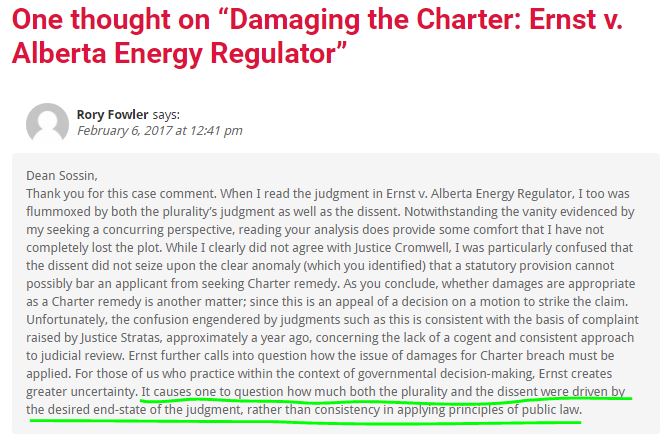 2017 03 12: Canadian Wheels of Justice by Greg Perry in Toronto Star
2017 03 12: Canadian Wheels of Justice by Greg Perry in Toronto Star
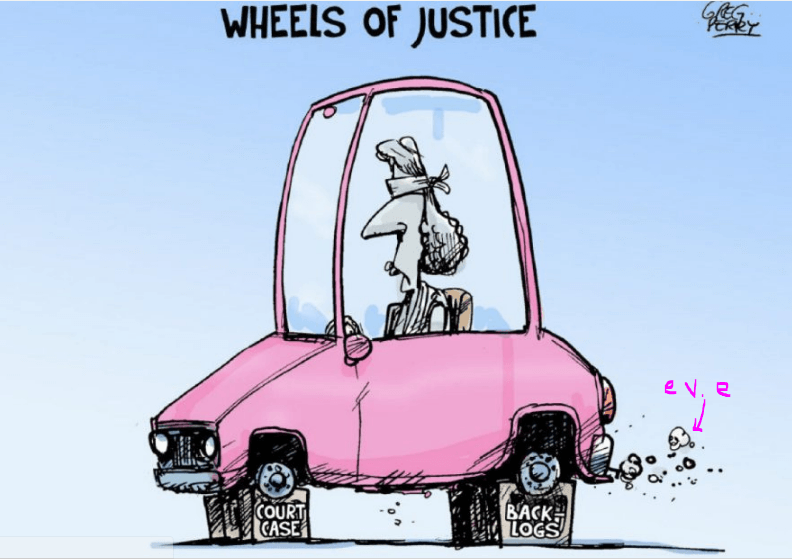 “e v. e” added (= the Ernst lawsuit, in the fumes going backwards).
“e v. e” added (= the Ernst lawsuit, in the fumes going backwards).
2017 02 14: Canada Judicial Council letter to Jessica Ernst, CJC File: 16-0545
The brochure referenced in the letter is digitally available here.
More details on filing complaints available here.
Who can make a complaint?
Any member of the public can make a complaint to the Council provided the complaint is about judicial conduct, is made in writing, and is about a specific federally appointed judge, the Council will review the matter.
Although the Minister of Justice or a provincial Attorney General can initiate a formal inquiry about a federally appointed judge, most complaints come from the general public.
…
In accordance with the complaints process, the Canadian Judicial Council can also initiate an inquiry into a judge’s conduct.
…
How do I make a complaint?
The Canadian Judicial Council seeks to ensure a fair process when a complaint is made against a judge. Every complaint is considered seriously and conscientiously.
You do not have to be represented by a lawyer if you want to make a complaint about a judge. You do not need to use a special form to make a complaint to the Council although one is offered here for your convenience. There is no fee charged and no deadline for making a complaint. The Council requires only that a complaint be
– in writing;
– about a named, federally appointed judge; and
– about the conduct of a judge and not their decision.
You can write a letter to the Canadian Judicial Council, and send it by regular mail (Canadian Judicial Council, Ottawa, Ontario, K1A 0W8) or by email. Your letter should include:
– your name and address;
– the name of the judge you are making a complaint against; and
– a description of the judge’s conduct that you believe was inappropriate. [Emphasis added]
***
Would Encana ask for Case Management to continue if it benefited anyone but Encana and the company’s pollution-enabler Alberta Environment?
2017 02 28: Comment by a citizen in BC:
dear Jessica. I am appalled at the Case Management dispute. HOW case management got into legal actions I do not know. And that it can be forced on a Plaintiff AMAZES me. And that you have to petition to have [your case heard] where it should [be heard] simply makes me CHOKE!!!!
Not only do the RCMP need to be torn up by the roots and completely replanted … but so does the Canadian Higher Court System. It is a farce, a disgrace, a plaything of rich Corporations! ! ! There’s no doubt we are at the spot the Roman Empire was as it began to fall apart from corruption, faking of institutions, elite rot….
It goes on and on and on and on … your case an elephant in the room that NO ONE will look at.
Fight on Jessica. I keep buying Lotto Tickets so you can be funded like a princess … but damn it!!!, I keep not winning. … You are a strength and inspiration. Remember that. [Emphasis added]
2017 02 27: Ernst letter to Justice Nixon responding to Encana’s request for Case Management
First, I should note that the first notice that Plaintiff’s counsel received regarding Encana’s proposed motion regarding case management was Ms. Killoran’s letter of February 23, 2017. Specifically, Ms. Killoran did not contact plaintiff’s counsel prior to sending this letter, to ascertain the plaintiff’s position on this proposed application.
In any event, my client would prefer that the action not be case managed as it is her view that case management has to date been harmful to her lawsuit. Nonetheless, in the circumstances, the plaintiff will not be opposing the defendants’ request. If the court does determine that case management is appropriate, my client respectfully requests that the court appoint a case management judge without input from any of the parties regarding who that judge should be. In the interests of saving the time of the court and all parties, my client also requests that Your Honour’s decision regarding case management be made without requiring the appearance of the parties. I would note that Chief Justice Wittmann stated specifically in His Honour’s letter of February 1, 2017 (attached) that the procedure to be followed is “in the discretion of Mr. Justice Nixon”, and accordingly we suggest neither a case conference nor formal application is required.
As a final point, my client wishes to stress the importance of the location of the lawsuit in the context of any order regarding case management. Ms. Ernst started the lawsuit in the appropriate judicial district of Drumheller/Hanna. This is, we suggest, clearly the district where the lawsuit belongs according to the Rules. The district of Drumheller/Hanna is where all events relevant to the lawsuit occurred, where the harm was alleged to have happened, where the defendants allegedly committed torts, and where Ms. Ernst’s home is. As a result, it is Ms. Ernst’s strong view that all applications related to the lawsuit must be heard in the district of Drumheller/Hanna regardless of any order made regarding case management. [Emphasis added]
2017 02 23: Letter from Encana taking up Justice Wittmann’s offer to formally apply to Justice Nixon requesting that Ernst vs Encana continue in case management. (Ernst has experienced directly over the last five years that case management is not in her interest and declined Justice Wittmann’s request that she negotiate with the defendants to select a new case management justice.)
Given the scheduled retirement of the Honourable Chief Justice Wittmann, Encana wishes to have a new Case Management Justice appointed. It is our understanding that: the Department of Justice supports the Encana Motion; and, the Plaintiff, does not. [Encana did not contact Ernst’s lawyers to ask]
2017 01 22: Why Bother about the Charter? The Supreme Court divides on whether one might claim Charter damages against an administrative tribunal Also on Canliiconnects: http://canliiconnects.org/en/commentaries/44596
Last week, the Supreme Court issued its first decision of 2017, Ernst v. Alberta Energy Regulator, 2017 SCC 1. One can only hope that it is not a trendsetter. The decisions raises more questions than it answers.
…. I want to focus on the question, which goes ostensibly unanswered in a 4-4 tie vote (Justice Abella abstaining), of whether Charter damages can be an appropriate and just remedy against an administrative tribunal. Justice Cromwell emphasizes the “need for balance with respect to the choice of remedies” for Charter breaches. [25] It is hard to be against “balance”, of course, but the question is how that balance is to be struck.
….while a personal immunity for judges is necessary to prevent the sort of ill-effects that worry Justice Cromwell, it is not so clear that the state should also benefit from this immunity.
… Of course defending Charter damages claims may be a distraction and a drain on an administrative tribunal’s resources. But that’s true for any government entity that could be subject to such damages. On Justice Cromwell’s logic, we might as well abolish this remedy (admittedly already underdeveloped and moribund as it is). And as for the worry that administrative decision-makers may suffer a “chilling effect” ― that is as much a feature as it is a bug. If we care about the constitution, shouldn’t we want government entities to worry about acting unconstitutionally, instead of being concerned that they will? Perhaps there is a level of concern that would be excessive. But are we anywhere near it? It is, as the dissent points out, for the government to prove that good governance considerations preclude Charter damages awards; Justice Cromwell’s reasons show no evidence of such proof having been produced (unsurprisingly at such a preliminary stage in the litigation).
…
Trust me when I say many of the facts the judges lay out in their decisions must have fallen out of the sky like manna for neither plaintiff or defendant plead those in their pleadings [Emphasis added]
2017 Comment from an Alberta rancher on the Supreme Court of Canada ruling:
Dear Jessica, I finished “Slick Water” the week before the decision was to come out. I prayed that the sins of man would be exposed for what they are but now fear that some eyes of the court believe, “It is easier to continue to make the error than admit the error”. This quote from page 174 of Judge Reilly’s book…of the dichotomy that exist for the Stony people that he tries to address in the book Bad Medicine. …
The way you have been treated by some along the way is hard to describe and I hoped the Supreme Court would address this as wrong.
… The responsibility of due diligence with the nature of fracking is passed around government and nobody does anything constructive to address concern except you. I fear the court has failed you and the split decision smells of politics….
2017 02 14: Happy Valentine’s Day! $15,337.04 invoice from Glenn Solomon and his Ottawa Agent for costs Ernst losing at Supreme Court of Canada, Ernst vs AER. The photocopy charges are outrageous as most are by most law firms.
2017 02 01: Letter from Chief Justice Neil Wittmann regarding non consensus on case management
2017 01 30: From letter Jessica Ernst to Chief Justice Neil Wittmann regarding his upcoming retirement and his offer that the parties in her lawsuit choose a replacement case management judge together:
Thank you for your letter of January 17, 2017.
Our client believes that case management is not in her interest and therefore requests that the matter no longer be subject to case management.
Our client also does not believe that it is appropriate for the parties to play a role in selecting a case management judge. Should the court determine that case management will proceed, our client requests that the court assign a judge without input from the parties.
2017 01 27: Letter Encana to Chief Justice Neil Wittmann, fully supporting the list of justices chosen by Alberta Justice to replace him as case management judge:
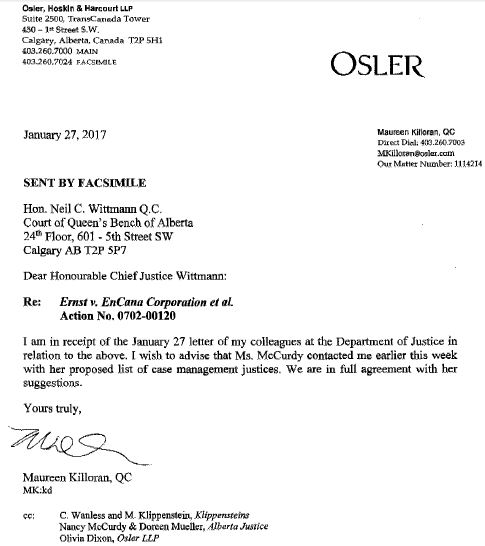
2017 01 27: Alberta Justice letter to Chief Justice Neil Wittmann, listing their six preferred justices to replace case management judge (Neil Wittmann) in Ernst vs Encana:
The six justices chosen by Alberta Justice are:
1. Justice B.E.C. Romaine
2. Justice R.E. Nation
3. Justice G.H. Poelman
4. Justice R.A. Neufeld
5. Justice J.T. Eamon
6. Justice K.D. Yamauchi
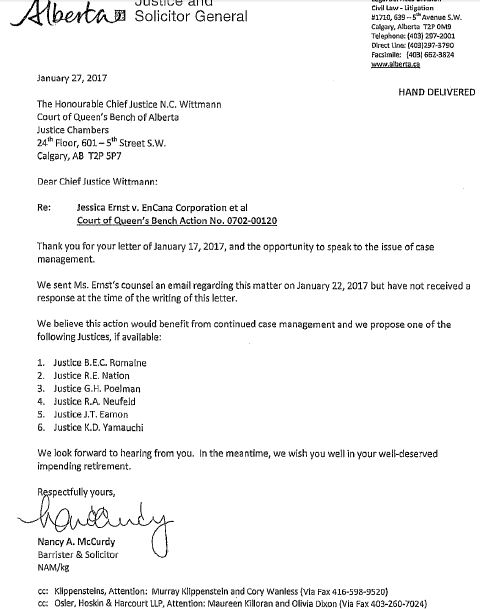
2017 01 20: Damaging the Charter: Ernst v. Alberta Energy Regulator
2017 01 19: The Canadian Courts’ Contradiction:
Courts have ruled that Ernst can sue the Alberta water regulator but not the AER, the energy regulator (the most guilty party *). Both are legally immune from lawsuits.

Snap above from the water regulator’s 2014 Application to Strike the Ernst lawsuit that failed and was not appealed. Ruling by Court of Queen’s Bench Chief Justice Wittmann.
More details on that court room drama 2014 04 18: Alberta Moves to Strike Down Ernst’s Fracking Lawsuit, Landmark case could spark a flood of litigation against the province, lawyer argues
Is the legal contradiction because the AER protects the fossil fuel industry?
*The AER abused its power and violated Ernst’s Charter rights trying to stop her from publicly exposing the energy regulator engaging in fraud covering up Encana’s law violations and drinking water contamination.
***
Should the parties wish a new case management judge, I would request they provide me with a list of four or five justices names by consent and I will reassign this file to one of those persons to continue case management.
Should the parties be unable to agree on a short list and still desire case management, I will appoint someone without the benefit of the parties’ agreement.
2017 01 17: A missed opportunity for justice
Shame on the Supreme Court of Canada. You missed an opportunity to provide justice for an aggrieved citizen. Shame!
2017 01 16: Condolences from Republic of Ireland:
We’re winning here because of you. When you told your story in the ballroom of romance in Glenfarne that night you turned the tide against the fracking industry. We’re going to ban fracking this year but you banned it first in the hearts of those local people. They believed you because of you honestly and your integrity. And you did it with Love.
We appreciate you. You reminded us to fight in a way that represented our values. That’s why we’re winning.
Slides from Ernst’s 2012 presentation in Glenfarne, Co Leitrim
Refer also to: Jessica Ernst packs hall at Ballroom of Romance
But this was no social outing that saw a full house of up to 350 people on Friday 24th February spilling out the door. … The men at the door were straining as if there lives depended on it, because it did. …
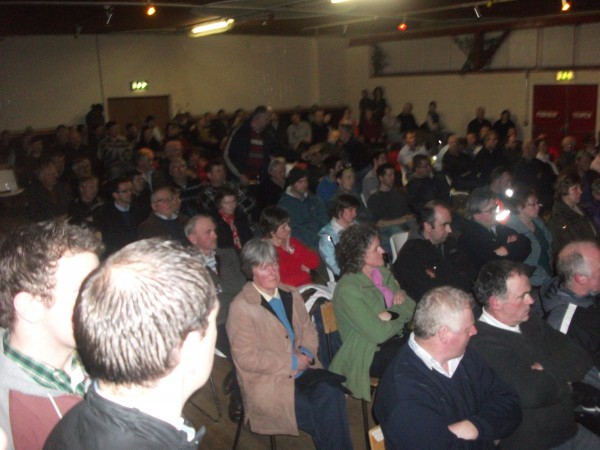
When asked what she would suggest as a course of action for Ireland on fracking, her message is simple: wait.
“The best advice I can give to people in Ireland is that the wise man learns from the mistakes of others. Watch the mistakes happen everywhere else,” she says.
2017 01 16: Acclaimed Canadian author lays out dirty back story of fossil fuel industry and government
2017 01 16: Die Another Day: The Supreme Court’s Decision in Ernst v Alberta Energy Regulator and the Future of Statutory Immunity Clauses for Charter Damages by Jennifer Koshan, ABlawg.ca
Justice Abella found that the lack of notice was determinative, using language that is quite harsh towards Ernst (see e.g. her reference to Alice in Wonderland at para 66), which is uncharacteristic of Justice Abella’s compassionate treatment of most Charter claimants.
2017 01 16: Alberta’s Lethbridge Herald poll:
Do you agree with the Supreme Court decision that Alberta’s energy regulator has immunity from being sued?
No: 82%
Yes: 18%
Poll results as of 4:50 pm, January 16, 2017
Poll ended at 5 pm, final results: 485 votes for “No,” 104 votes for “Yes.”
2017 01 13: A year and a day to wait for the ruling after a year and two months of Supreme Court of Canada process
2017 01 13: The SCC press release was released much later than the ruling:
The appeal from the judgment of the Court of Appeal of Alberta (Calgary), Number 1301-0346-AC, 2014 ABCA 285, dated September 15, 2014, heard on January 12, 2016, is dismissed with costs. McLachlin C.J. and Moldaver, Côté and Brown JJ. are dissenting.
L’appel interjeté contre l’arrêt de la Cour d’appel de l’Alberta (Calgary), numéro 1301-0346-AC, 2014 ABCA 285, daté du 15 septembre 2014, entendu le 12 janvier 2016, est rejeté avec dépens. La juge en chef McLachlin et les juges Moldaver, Côté et Brown sont dissidents.
2017 01 13: The Supreme Court of Canada Ruling: Ernst v. Alberta Energy Regulator
Ernst lost in a three way split 4/1/4 decision
A few tweets:
Avnish Nanda @avnishnanda Ernst is a good example of why #SCC needs regional balance. Majority + Abella don’t understand Alberta law
…
Aaron Dantowiz @AaronDantowitz If only 4 of 9 Supreme Court judges decide a constitutional issue, is it decided?
Avnish Nanda @avnishnanda Ernst lost, but what’s the law? Four say s. 43 bars Charter damage claims, one says “not sure yet”, and four say it doesn’t in this case.
Supreme Court of Canada Facebook Page For some reason, the Supreme Court isn’t allowing comments to be visible anymore.
2017 01 14 Comment posted to SCC’s FB page by Julie Ali: I am frankly confused by the SCC decision with reference to the Jessica Ernst case. The majority of the judges indicate to the public that Jessica Ernst should have requested a judicial review instead of bothering them. Now I guess the judges aren’t ordinary citizens because if they were they would realise it is impossible to get the GOA or the AER to respond to our e-mails much less provide us with a judicial review. I would respectfully suggest to the SCC judges who refused to let Jessica Ernst sue the regulator that they are wrong. As well they have let down citizens who are now impeded from any sort of recourse when dealing with energy regulators that are the front offices of big oil. I am not impressed by the work of the SCC in this case
2017 01 11: Barb Ryan: Looking foward to the SCC upholding the Charter and thereby guiding future discussions toward abolishing blanket immunity clauses.
2017 01 10: Johanne Dion: Can’t wait to hear about Friday’s ruling in Jessica Ernst’s case.
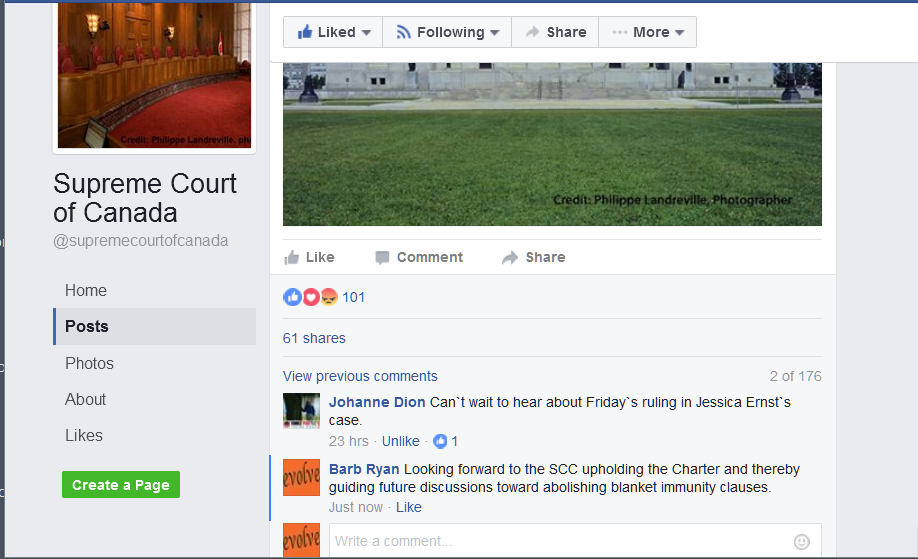
2017 01 09 Rena Woss: Jessica Ernst case is one I’ve been following; hoping that environment will finally win out over corporate interest. Just heard that Supreme Court of Canada will rule this Fri. Jan. 13th. Waiting over a year has been grueling for those of us who want to see justice for people like Jessica who are working to protect our water. https://thetyee.ca/…/01/13/Supreme-Court-Fracking-Battle/
https://ernstversusencana.ca/
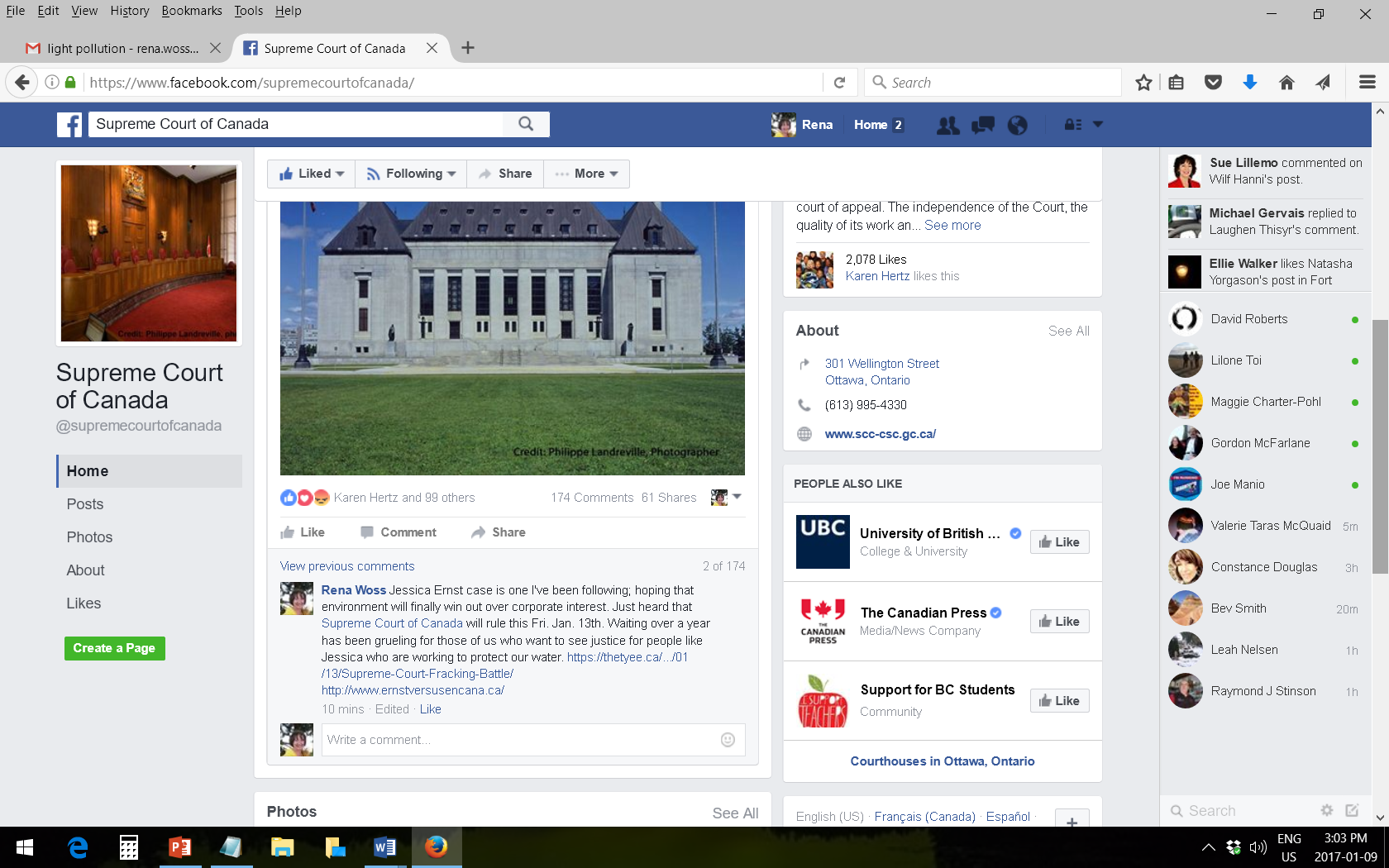
2016 Supreme Court of Canada Appeals/Motions Heard:
Green = Ruling released
Grey = Ruling not yet released
FALL SESSION (2016):
December 9, 2016 [Date of Hearing] Brent Bish on behalf of Ian Stewart v. Elk Valley Coal Corporation, Cardinal River Operations et al. (Alta.) (Civil) (By Leave) (36636)
December 8, 2016 Dion Henry Alex v. Her Majesty the Queen (B.C.) (Criminal) (By Leave) ((36771)
December 6, 2016 Google Inc. v. Equustek Solutions Inc. et al. (B.C.) (Civil) (By Leave) (36602)
December 5, 2016 Directeur des poursuites criminelles et pénales c. Robert Jodoin (Qc) (Criminal) (By Leave) (36539)
December 2, 2016 Her Majesty the Queen in Right of Canada v. Kevin Antic (Ont.) (Criminal) (By Leave) (36783)
December 1, 2016 Ktunaxa Nation Council and Kathryn Teneese, on their own behalf and on behalf of all citizens of the Ktunaxa Nation v. Minister of Forests, Lands and Natural Resource Operations et al. (B.C.) (Civil) (By Leave) (36664)
November 30, 2016 Chippewas of the Thames First Nation v. Enbridge Pipelines Inc. et al. (F.C.) (Civil) (By Leave) (36776)
November 30, 2016 Hamlet of Clyde River et al. v. Petroleum Geo-Services Inc. (PGS) et al. (F.C.) (Civil) (By Leave) (36692)
November 29, 2016 Andrus Wilson v. Ramzi Mahmoud Alharayeri (Que.) (Civil) (By Leave) (36689)
November 10, 2016 British Columbia Teachers’ Federation, on behalf of all members of the British Columbia Teachers’ Federation v. Her Majesty the Queen in Right of the Province of British Columbia (B.C.) (Civil) (By Leave) (36500) Ruling from the Bench
November 9, 2016 Sidney Green v. Law Society of Manitoba (Man.) (Civil) (By Leave) (36583)
November 8, 2016 AstraZeneca Canada Inc. et al. v. Apotex Inc. et al. (F.C.) (Civil) (By Leave) (36654)
November 4, 2016 Deborah Louise Douez v. Facebook, Inc. (B.C.) (Civil) (By Leave) (36616)
November 3, 2016 Her Majesty the Queen v. Robert David Nicholas Bradshaw (B.C.) (Criminal) (By Leave) (36537)
November 2, 2016 Brendan Paterson v. Her Majesty the Queen (B.C.) (Criminal) (By Leave) (36472)
November 1, 2016 Teal Cedar Products Ltd. v. Her Majesty the Queen in Right of the Province of British Columbia(B.C.) (Civil) (By Leave) (36595)
November 1, 2016 Urban Communications Inc. v. BCNET Networking Society (B.C.) (Civil) (By Leave) (36639) Ruling from the Bench.
October 31, 2016 Dennis James Oland v. Her Majesty the Queen (N.B.) (Criminal) (By Leave) (36986)
October 14, 2016 Eric Andrew Rowson v. Her Majesty the Queen (Alta) (Criminal) (As of Right) (36777) Ruling from the Bench
October 14, 2016 Her Majesty the Queen v. C. K-D. (Ont.) (Criminal) (As of Right) (36877) Ruling from the Bench
October 13, 2016 Carson Bingley v. Her Majesty the Queen (Ont.) (Criminal) (By Leave) (36610)
October 12, 2016 Scott Diamond v. Her Majesty the Queen in Right of Newfoundland and Labrador et al. (N.L.) (Criminal) (As of Right) (36816) Ruling from the Bench.
October 11, 2016 BC Freedom of Information and Privacy Association v. Attorney General of British Columbia (B.C.) (Civil) (By Leave) (36495)
October 7, 2016 Alain Ostiguy et autre c. Hélène Allie (Qc) (Civile) (Autorisation) (36694)
October 7, 2016 Corporation of the City of Nelson v. Mary Geraldine Mowatt et al. (B.C.) (Civil) (By Leave) (36999)
October 6, 2016 Thérèse Godbout et autres c. Jean-Maurice Pagé et autres (Qc) (Civile) (Autorisation) (36385)
October 6, 2016 Gilles Gargantiel v. Attorney General of Quebec (Que.) (Civil) (By Leave) (36388)
October 5, 2016 Andrew Sabean v. Portage La Prairie Mutual Insurance Company (N.S.) (Civil) (By Leave) (36575)
SPRING (& winter) SESSION (2016):
May 20, 2016 Shane Rayshawn Vassell v. Her Majesty the Queen (Alta.) (Criminal) (As of Right) (36792) Five weeks & four days to rule.
May 19, 2016 Anita Endean, as representative plaintiff v. Her Majesty the Queen in Right of the Province of British Columbia et al. (B.C.) (Civil) (By Leave) (35843) Twenty-two weeks to rule.
May 19, 2016 Dianna Louise Parsons, deceased by her Estate Administrator, William John Forsyth et al. v. Her Majesty the Queen in Right of Ontario et al. (Ont.) (Civil) (By Leave) (36456) Twenty-two weeks to rule.
May 18, 2016 Groupe Jean Coutu (PJC) inc. c. Procureur général du Canada (Qc) (Civile) (Autorisation) (36505) Twenty-nine weeks & 2 days to rule.
May 18, 2016 Attorney General of Canada v. Fairmont Hotels Inc. et al. (Ont.) (Civil) (By Leave) (36606) Twenty-nine weeks & 2 days to rule.
April 29, 2016 John Thomas Shaoulle v. Her Majesty the Queen (Sask.) (Criminal) (As of Right) (36704) Ruling from the Bench
April 29, 2016 Pierre-Olivier Laliberté c. Sa Majesté la Reine (Qc) (Criminelle) (De plein droit) (36712) Ruling from the Bench
April 28, 2016 Albert Benhaim et al. v. Cathie St-Germain, personally and in her capacity as tutor to her minor son, whose name is being kept confidential, and in her capacity as universal legatee of the late Marc Émond (Que.) (Civil) (By Leave) (36291) Twenty-eight weeks to rule.
April 27, 2016 Royal Bank of Canada v. Phat Trang, Phuong Trang a.k.a. Phuong Thi Trang et al. (Ont.) (Civil) (By Leave) (36296) Twenty-nine weeks & one day to rule.
April 26, 2016 Musqueam Indian Band v. Musqueam Indian Band Board of Review et al. (B.C.) (Civil) (By Leave) (36478) Nineteen weeks & three days to rule.
April 25, 2016 Her Majesty the Queen v. Ordinary Seaman Cawthorne (C.M.A.C.) (Criminal) (As of Right) (36466) Twelve weeks & four days to rule.
April 25, 2016 Sa Majesté la Reine c. Adjudant J.G.A. Gagnon et autre (C.A.C.M.) (Criminelle) (Autorisation) (36844) Twelve weeks & four days to rule.
April 22, 2016 Jean-François Morasse c. Gabriel Nadeau-Dubois (Qc) (Civile) (Autorisation) (36351) Twenty-sevent weeks to rule.
April 21, 2016 Corporation of the City of Windsor v. Canadian Transit Company (F.C.) (Civil) (By Leave) (36465) Thirty-three weeks to rule.
April 1, 2016 Information and Privacy Commissioner of Alberta v. Board of Governors of the University of Calgary (Alta.) (Civil) (By Leave) (36460) Thirty-four weeks to rule.
March 31, 2016 Matthew John Anthony-Cook v. Her Majesty the Queen (B.C.) (Criminal) (By Leave) (36410) Twenty-nine weeks & one day to rule.
March 30, 2016 Ledcor Construction Limited et al. v. Northbridge Indemnity Insurance Company et al. (Alta.) (Civil) (By Leave) (36452) Twenty-one weeks & three days to rule.
March 29, 2016 Attorney General of Canada v. Igloo Vikski Inc. (F.C.) (Civil) (By Leave) (36258) Twenty-three weeks & three days to rule.
March 24, 2016 Karine Lizotte, ès qualités de syndic adjoint de la Chambre de l’assurance de dommages c. Aviva, Compagnie d’assurance du Canada et autre (Qc) (Civile) (Autorisation) (36373) Thirty-five weeks & one day to rule.
March 23, 2016 City of Edmonton v. Edmonton East (Capilano) Shopping Centres Limited (as represented by AEC International Inc.) (Alta.) (Civil) (By Leave) (36403) Thirty-two weeks & two days to rule.
March 22, 2016 Alan Peter Knapczyk v. Her Majesty the Queen (Alta.) (Criminal) (As of Right) (36612) Ruling from the Bench.
March 22, 2016 John Reginald Alcantara v. Her Majesty the Queen (Alta.) (Criminal) (As of Right) (36613) Ruling from the Bench.
March 21, 2016 Her Majesty the Queen v. Oswald Oliver Villaroman (Alta.) (Criminal) (By Leave) (36435) Seventeen weeks & four days to rule.
February 25, 2016 Her Majesty the Queen v. Michael Bruce Newman (B.C.) (Criminal) (As of Right / By Leave) (36524) Ruling from the Bench.
February 23, 2016 Frédéric Gagnon c. Sa Majesté la Reine (Qc) (Criminelle) (De plein droit) (36581) Ruling from the Bench.
January 22, 2016 Heritage Capital Corporation v. Equitable Trust Company et al. (Alta.) (Civil) (By Leave) (36301) Fifteen weeks to rule.
January 21, 2016 Jonathan David Meer v. Her Majesty the Queen (Alta.) (Criminal) (As of Right / By Leave) (36448) Ruling from the Bench
January 20, 2016 Her Majesty the Queen v. Meredith Katharine Borowiec (Alta.) (Criminal) (As of Right) (36585) Nine weeks & one day to rule.
January 19, 2016 Joseph Wilson v. Atomic Energy of Canada Limited (F.C.) (Civil) (By Leave) (36354) Twenty-five weeks & two days to rule.
January 18, 2016 Conférence des juges de paix magistrats du Québec et autres c. Procureure générale du Québec et autres (Qc) (Civile) (Autorisation) (36165) Thirty-eight weeks & four days to rule.
January 15, 2016 Akeem Smith Seruhungo v. Her Majesty the Queen (Alta.) (Criminal) (As of Right) (36523) Ruling from the Bench.
January 15, 2016 Johnathan Peter Spicer v. Her Majesty the Queen (Alta.) (Criminal) (As of Right) (36532) Ruling from the Bench.
January 14, 2016 Workers’ Compensation Appeal Tribunal et al. v. Fraser Health Authority et al. (B.C.) (Civil) (By Leave) (36300) Thirty weeks & three days to rule.
January 13, 2016 Joseph Ryan Lloyd v. Her Majesty the Queen (B.C.) (Criminal) (By Leave) (35982) Thirteen weeks & two days to rule.
January 12, 2016 Jessica Ernst v. Alberta Energy Regulator (Alta.) (Civil) (By Leave) (36167)
January 11, 2016 Lee Carter et al. v. Attorney General of Canada et al. (B.C.) (Civil) (By Leave) (35591) Ruling from the Bench.
***
2004 Ethical Principals for Judges by Canadian Judicial Council
10. The proper preparation of judgments is frequently difficult and time consuming. However, the decision and reasons should be produced by the judge as soon as reasonably possible, having due regard to the urgency of the matter and other special circumstances. Special circumstances may include illness, the length or complexity of the case, an unusually heavy workload or other factors making it impossible to give judgment sooner. In 1985, the Canadian Judicial Council resolved that, in its view, reserved judgments should be delivered within six months after hearings, except in special circumstances.
[In the four court rulings on the Ernst lawsuit so far (all on merely preliminary motions), only one was delivered within six months.]
***
2016 12 19: Happy Anniversary! Two years Ernst has now waited for Encana to heed Justice Wittmann’s July 2014 Order to file all important and relevant documents with her.
Chemicals illegally injected repeatedly by Encana in 2004 directly into Rosebud’s drinking water aquifers remain secret, contrary even to Alberta’s Rules of Court.
Encana still has not filed with Ernst cleaned up records for document exchange; chemicals injected into Rosebud’s drinking water aquifers are required to be disclosed to Ernst under Alberta’s Rules of Court, including all trade secrets.
Encana has also not disclosed the chemicals the company secretly injected into hundreds of other gas wells in various formations in fresh water zones around the community; numerous other important and relevant documents remain withheld.
2016 10 16: Encana compressors roaring noisily; Encana has violated Ernst’s legal right to quiet enjoyment of her home and land for more than thirteen years now. Where’s the regulator ordering Encana to shut down the noise?
2016 07 20: Posting of July 13 receipt of media lock-up forms from AER and Ernst (Ernst has not yet been copied AER’s consent form. If Ernst is copied, it will be made public here):
2016 07 12: Klippenstein’s letter to Supreme Court of Canada, Ernst declines consent to the Canadian Parliamentary Press Gallery’s request for media lock-up: “Jessica Ernst believes that it is better and fairer if the public and all media have equal access to the judgment in this case at the same time”
2016 07 07: The Supreme Court of Canada’s Media Lock-up letter (lock-up was requested by the Canadian Parliamentary Press Gallery) to parties 3 page PDF including letter snapped below:
If Canadian Parliamentary Press Gallery (CPPG) members were concerned about or interested in Ernst vs AER, why didn’t they attend the January 2016 Supreme Court of Canada hearing and report on it? Andrew Nikiforuk (not a member) flew to Ottawa from Campbell River, BC, on his own dime, to attend the hearing and report on it. If there is a media lock-up, only CPPG members are allowed in. Nikiforuk has been reporting on the case for 12 years and reported on it in his new book Slick Water.
The media lock-up request was posted to the Ernst vs AER docket July 2016.
The Supreme Court of Canada has adopted a procedure, requiring the consent of counsel, for holding closed-door information sessions (media lock-ups) at which members of the Canadian Parliamentary Press Gallery (“CPPG”) can review certain judgments just before their scheduled public release. This procedure gives members of the media who wish to report on a judgment time to examine it before it becomes public. The purposes of the lock-up procedure are to improve the accuracy of media reporting of Supreme Court of Canada decisions and to assist members of the media in reporting on cases that have attracted a high level of public interest. Consent to a media lock-up must be obtained from counsel of record for the parties, and counsel who have consented to that lock-up may request a separate lock-up for counsel. No briefing is given to counsel at a counsel lock-up. For further information, consult the Procedure for Lock-ups.
1. Request for a Lock-up
1.1 The President of the Canadian Parliamentary Press Gallery (“CPPG”) may write to the Registrar of the Supreme Court of Canada (“SCC” or the “Court”) to request a media lock-up for any appeal (the “Appeal”) no later than one month after the Court hears the Appeal. Only the President of the CPPG may request a media lock-up.
1.2 Where the Court deems the case appropriate for a media lock-up, the Registrar will request written consent to the media lock-up from counsel of record for the parties. Counsel for interveners, if any, on the Appeal will not be consulted.
1.3 If any counsel of record for a party refuses to consent to a media lock-up on the Appeal, no media lock-up will be held. If counsel of record for a party consents to the media lock-up, he or she may request a separate lock-up for counsel.
1.4 Given other demands on the limited resources of the Court, only a limited number of cases can be subject to lock-ups. The Court may refuse to hold a lock-up for any reason, notwithstanding the consent of counsel of record for the parties.
1.5 The Registrar will advise the President of the CPPG and counsel of record for the parties and interveners, if any, of the Court’s decision whether to hold a lock-up on the Appeal.
2. Who May Attend Lock-up
2.1 Only media representatives and counsel of record for the parties and interveners, or their agents, will be allowed to attend the lock-up in accordance with the following two paragraphs. No parties, interveners, experts or analysts will be permitted to attend any lock-up.
2.2 Only media representatives accredited by the CPPG will be admitted to the media lock-up. CPPG accreditation must be secured by each media representative before the lock-up.
2.3 Only counsel of record for each party and for each intervener on the Appeal and/or their respective agents, will be admitted to the counsel lock-up. Counsel and agents will be required to confirm their attendance with the Registry when the Registry informs them of the lock-up/judgment release date.
3. Notice of Lock-up/Judgment Release Date
3.1 Approximately one week before the date of the lock-up, counsel of record for the parties and interveners, and their agents, will be informed of the date of the lock-up/release of judgment on the Appeal. The Court will send out a notice of the date and time of the lock-up/release of judgment on the Appeal to the CPPG after counsel have been advised.
4. Pre-briefing for Media
On any appeal where there is a lock-up, a pre-briefing for the media will be given where possible, normally a day or two before the date of the lock-up/judgment release date. The pre-briefing will cover the background issues (facts, lower court decisions, arguments by the parties, etc.). The matters covered at the pre-briefing will not be covered again at the media lock-up.
5. Procedure on Day of Lock-up
5.1 The media lock-up and the counsel lock-up will be held on the day the judgment in the Appeal is released. Only one judgment will be released at any lock-up.
5.2 Normally, the media lock-up will be held in the SCC Press Room.
5.3 The counsel lock-up will be held in a room to be designated at the SCC.
5.4 All members of the media and all counsel of record for the parties and interveners, or their agents, who attend the lock-up shall give a signed undertaking (the “Undertaking”) that he or she will not engage in any external communications for the duration of the lock-up. No one will be permitted to attend the lock-up unless the Undertaking is given. As a term of the Undertaking, all electronic communication devices shall be surrendered to a Court staff member for the duration of the lock-up. A copy of the Undertaking is attached.
5.5 The President of the CPPG or his or her designate will be present prior to and during the media lock-up to verify CPPG accreditation and to collect the Undertakings and remit them to a Court staff member who will be present to collect Undertakings and electronic communication devices. A Court security officer will also be present.
5.6 A Court staff member will be present outside the counsel lock-up to verify counsel’s identity and to collect the Undertakings. A Court security officer will also be present.
5.7 Both the media lock-up and counsel lock-up will start at the same time, normally 8:15 a.m. The reasons for judgment will be distributed at the commencement of the lock-up. No one will be allowed to leave the lock-up prior to 9:45 a.m., or the time the judgment is released to the public, whichever is later.
5.8 Briefing at media lock-up:
- Reporters will be given 15 minutes alone to read the judgment at the beginning of the lock-up.
- There will then be a one half-hour briefing by the Executive Legal Officer, or his or her designate, on the reasons for judgment. The briefing is not-for-attribution.
- The Executive Legal Officer, or his or her designate, will then answer questions.
5.9 No briefing will be given to counsel at the counsel lock-up.
5.10 The media lock-up and counsel lock-up will end at 9:45 a.m., or the time the judgment is officially released to the public, whichever is later.
Rights of SCC
The purpose of a media lock-up is to improve the accuracy of reporting of decisions of the Court and to assist members of the media in high profile cases where there is a high level of public interest. The Court appreciates input from the CPPG to improve the procedure applicable to lock-ups. However, the Court reserves the right to refuse a lock-up, the right to change the procedure applicable to lock-ups, and the right to discontinue lock-ups.
Inquiries
For information on lock-ups, please contact:
Counsel Inquiries
Registry
613-996-8666
Media Inquiries
Gib van Ert, Executive Legal Officer
613-996-9296
Rémi Samson, Legal Officer
613-996-6289
Undertaking for Media Admission to Lock-up at the Supreme Court of Canada
- that I will remain in the Lock-up until the time when an official of the Supreme Court of Canada announces that the Lock-up is released;
- that all documents, materials, or information made available to me remain the property of the Supreme Court until the termination of the Lock-up and that under no circumstances will I remove, release or communicate any such documents, materials or information, or other records of any nature whatsoever in any manner (including the use of wireless communication devices such as cellular phones, two-way radios, personal digital assistants and wireless microphones) relating thereto or derived therefrom, before the termination of the Lock-up;
- that I have turned in any cellular phones, two-way radios, personal digital assistants, wireless microphones or other wireless communication devices which will be held until the end of the Lock-up; and,
- that should I breach any of the terms of this undertaking, I recognize that the Supreme Court of Canada may decide to cancel future Lock-ups and that, as a Gallery member, I may be subject to sanction(s) by the Canadian Parliamentary Press Gallery
…
In order for leave to appeal to be granted by the Court, a case must be of national or public importance or involve conflicting decisions on some point of law between two or more provincial courts of appeal. Some of the appeals heard by the Court attract a higher than usual level of public and media interest and due to their complexity could benefit from a longer briefing. As a result of consultations with the CPPG, the Court has implemented a procedure for holding lock-ups in certain high-profile, complex cases. A lock-up may be granted by the Court, but only if counsel for the parties consent and the Court decides it appropriate. See Notice to the Profession on Press Lock-up.
When a lock-up is held, accredited members of the CPPG are briefed on the decision before it is released to the general public. Only accredited members of the CPPG are permitted to attend. Counsel for the parties and interveners may choose to attend a separate counsel lock-up. Everyone who enters the lock-up must surrender all electronic communications devices such as cell phones and handheld communication devices, and must undertake not to communicate with anyone outside the lock-up until the lock-up ends. The lock-up ends when the decision is released to the public, which is usually 9:45 a.m. ET.
Requests for lock-ups are made by the President of the Canadian Parliamentary Press Gallery or his or her designate. More details are available in the Procedure for Lock-ups.
Administration at the Supreme Court of Canada: Challenges and change in the Charter era
Pg. 15 “Engaging the media”
When the Press Gallery reiterated its request for lockups, some judges still had significant concerns about the process. They generally felt that no one should know the outcome of a case before the litigants. …
….lockups are typically held for controversial or widely covered cases…. [Emphasis added]
Ontario Court of Appeal’s first media lockup worked
… The Supreme Court of Canada has since 2004 held media lockups about two or three times a year for vital or complicated decisions when the Canadian Parliamentary Press Gallery requests them, says the Supreme Court of Canada’s legal officer Witold Tymowski. [Emphasis added]
***
Award Winning Investigative Journalist Andrew Nikiforuk attended the January 12, 2016 hearing and reported on it (Parliamentary Press Gallery members did not):
2016 01 12: Webcast Supreme Court of Canada hearing Ernst vs AER, 2.5 hours. (Some browsers won’t play it, Firefox, Safari, Internet Explorer do.)
Reminder: Glenn Solomon, counsel for the AER, repeatedly lies in his “Fact”um and misstates Ernst’s Factum and those of the Inteverners (all accessible further below):
The AER’s factum:
55. On Ms. Ernst’s construction, to immunize these judicial decision-makers from claims for personal Charter damages would “gut the remedial power of 24(1)” and “cannot be countenanced.”97 [Appellant’s Factum at para. 67.]
Ernst’s factum at para. 67 doesn’t mention judicial decision-makers:
67. Moreover, the effect of upholding the Court of Appeal’s ruling would be immediate and, in the Appellant’s view, disastrous. General statutory immunity clauses are very common across Canada; there are currently nearly identical statutory immunity clauses in the statute books of every jurisdiction in Canada.83 A ruling that s. 43 of the ERCA is constitutionally applicable to claims for personal remedies pursuant to s. 24(1) of the Charter would mean that dozens of other general statutory immunity clauses also block any and all attempts by Canadians to challenge the constitutionality of the actions taken by hundreds of governments and government agencies across Canada. Such a finding would gut the remedial power of 24(1), and render functionally useless this Court’s previous jurisprudence on s. 24(1). Such a result cannot be countenanced
Court Hearing starts at 90:29 Min.
Cory Wanless, counsel for Ernst, presents to 152:28 Min.
Ryan Dalziel, counsel for Intervener, British Columbia Civil Liberties Association, 152:40 – 163:28 Min.
Raj Anand, counsel for Intervener, David Asper Centre, 163:28 – 174:41 Min.
Break goes to 191:22 Min.
Glenn Solomon, counsel for AER, 191:22 – 238:40 Min.
“How you get in, starts with a prior assertion. I don’t want to offend anyone by saying it, but you’ve opened a brave new world, in terms of Charter damages.”
Cory Wanless, Reply 238:50 – 250:08 Min. (End)
Judgment reserved OR rendered with reasons to follow
2016 01 08: Attorney General of Quebec chose not to appear.
2016 01 07: Supreme Court Order granting BC Civil Liberties Association and David Asper Centre 10 minutes each to present oral argument at the hearing and the Quebec AG 15 minutes (Click link or snap below to read in French)
2016 01 06: AER Reply Factum to Intervener Factums (accessible below) and Book of Authorities
After misrepresenting Alberta’s Responsible Energy Development Act (REDA), Ernst’s Factum and Statement of Claim and lying about Ernst in the AER’s Factum, the AER misrepresents Factums of the Interveners in the AER Reply Factum:
From the BC Civil Liberties Association’s Factum:
This is a case about the day-in-and-day-out workings of bureaucrats said to have run amok to a degree harmful to freedom of expression. … The regulator has no business seeking to punish those with whom it communicates; doing so would thus amount to an “abuse of power”.
From AER’s Reply Factum, Page 6:
15. The CCLA, BCCLA and the David Asper Centre all assert that the Appellant has made out a valid cause of action. 28 The BCCLA goes further, positing that the AER arguably engaged in conduct it had “no business” engaging in, and that the impugned conduct of the AER may have amounted to “an abuse of power”.29 This Appeal arises from an application to strike or to summarily dismiss the Plaintiff’s fourth iteration of her Statement of Claim. The BCCLA should not, through an intervener’s Factum, be seeking to redraft the Plaintiff’s pleadings. An intervener has no place entering the fray by making new allegations of abuse of power.
2015 12 30: Kent Roach appointed Member of the Order of Canada. (Affidavit of Kent Roach was filed in David Asper Centre’s Motion for Leave to Intervene in Ernst vs AER. Intervener Factums included below; the Court is deciding whether or not to grant interveners hearing time.)
2015 12 29: Press Release by Supreme Court of Canada / Cour suprême du Canada
The Supreme Court of Canada announced today the list of motions and appeals that will be heard in January. This list is subject to change.
La Cour suprême du Canada a publié aujourd’hui la liste des requêtes et appels qui seront entendus en janvier. Cette liste est sujette à modification
2016-01-12 Jessica Ernst v. Alberta Energy Regulator (Alta.) (Civil) (By Leave) (36167)
NOTE: This agenda is subject to change. Hearings normally commence at 9:30 a.m.; however, cases with multiple parties often commence at 9:00 a.m. … Hearing dates and times should be confirmed with Registry staff at 613-996-8666.
Ce calendrier est sujet à modification. Les audiences débutent normalement à 9h30; toutefois; l’audition des affaires concernant des parties multiples commence souvent à 9 h. … La date et l’heure d’une audience doivent être confirmées auprès du personnel du greffe au 613-996-8666.
2015 12 23: Canadian Civil Liberties Association files Factum and Book of Authorities Vol 1 and Vol 2
2015 12 22: Quebec Attorney General files Factum/mémoire de l’intervenante PGQ and Book of Authorities Vol 1 (13.5 MB) and Vol 2 (16.8 MB)
The Attorney Generals of Canada, BC and Saskatchewan withdrew (filings included below).
2015 12 22: David Asper Centre files Factum and Book of Authorities
2015 12 21: Attorney General of Saskatchewan files Notice of Withdrawal
2015 12 19 HAPPY ANNIVERSARY & MERRY CHRISTMAS! CHEMICALS ILLEGALLY INJECTED BY ENCANA IN 2004 INTO ROSEBUD’S DRINKING WATER AQUIFERS REMAIN SECRET, CONTRARY EVEN TO ALBERTA’S RULES OF COURT:
Encana still has not filed with Ernst cleaned up records for their document exchange (which had a December 19, 2014 deadline ordered by Chief Justice Wittmann); chemicals Encana injected into Rosebud’s drinking water aquifers also not yet disclosed, even though required under the Court Rules, including all trade secrets.
From November 4, 2015 Supreme Court Order:
The respondent [AER] is permitted to serve and file a single factum not exceeding ten (10) pages in reply to these interventions on or before January 7, 2016.
2015 12 17: Attorney General of Canada files Notice of Withdrawal
2015 12 17: Attorney General of British Columbia files Notice of Withdrawal
From: Brigitte Raymond [mailto:[email protected]]
Sent: Thursday, December 17, 2015 3:49 PM
To: email hidden; JavaScript is required
Cc: Chris Rootham; Rupar, Christopher; Beedell, Jeff; Watt, Lynne; email hidden; JavaScript is required; email hidden; JavaScript is required; email hidden; JavaScript is required; Robert Houston; Collins, Karen; Christie, Christina; email hidden; JavaScript is required
Subject: Ernst v. Alberta Energy Regulator / SCC #36167
Please find attached an electronic copy of a Notice of Withdrawal on behalf of the Attorney General of British Columbia.
The hard copy will be served and filed tomorrow.
Kind Regards,
Brigitte Raymond | Law Clerk
BURKE-ROBERTSON LLP
613-236-9665 ext 257
441 MacLaren St. Suite 200 | Ottawa, ON K2P 2H3
main 613-236-9665 |fax 613-235-4430
www.burkerobertson.com
2015 12 17: Intervenor BC Civil Liberties Association files Factum & Book of Authorities
2015 11 26: Supreme Court of Canada scheduled the appeal hearing for January 12, 2016 (previously it was tentatively set). Click to read the Court’s letter and hearing notice.
2015 12 03: Gowling’s Jeff Beedell, Ottawa agent for AER, responds to Rupert Goodhart’s motion for leave to intervene. The AER and Gowlings never asked Ernst or her lawyers for permission to speak on her behalf. Ernst is happy to read any late submission, formal or informal, at any time, and is keeping her Christmas schedule empty so she has ample time to read the intervenor factums and any late filings. (The Supreme Court set the intervenor factum filing deadline for December 23, 2015.) The hearing is, after all, about whether or not Charter rights of Canadians can be trumped by energy regulators and their enabling governments. Christmas can wait.
***
2015 11 24: November 9, 2015 Letter from Supreme Court of Canada on the Rosebud community petition to the court signed by 74 residents
“On behalf of the Supreme Court of Canada, we acknowledge receipt of your letter of November 1, 2015 and your petition concerning the Jessica Ernst vs Alberta Energy Regulator case (docket 36167). Your correspondence has been referred to me for reply. I regret to inform you that the Court is only permitted to consider material submitted by parties to an action or by an intervener. I am also sure that you will understand that it would be inappropriate for the court to comment on a case presently before it.”
Chantal Portelance
Director, Communication Services
2015 11 19: Ernst Reply Factum
Ernst Book of Authorities, Reply Factum
2015 11 06: Letter in support of Ernst by Diana, Derek, Dagan and Deity Daunheimer
2015 11 06: AER’s Factum repeatedly misstates Ernst’s claim and her Factum.
In 2004, when the EUB violated Ernst’s Charter rights, it was a government agency mandated to regulate industry in the public interest.
After the Ernst lawsuit went public, the Alberta government created REDA and turned the regulator into a corporation and removed “public interest” from it’s mandate.
The AER’s factum states:
6. The AER is a statutory agency responsible for regulating the development of Alberta’s energy resources. Through its governing statutes, it has broad purposes that range from the conservation of energy resources in Alberta, to appraising energy resources in Alberta, and providing for the economic, orderly and efficient development of the oil and gas resources of Alberta in the public interest. [AER’s counsel Glenn Solomon didn’t reference this statement.]
From REDA – the Alberta government’s legislation that created the AER: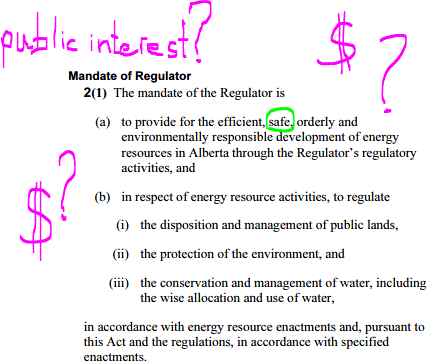
The AER’s factum states:
39. … Ms. Ernst claims in her Factum that she seeks declaratory relief in respect of her Charter claim.76 [ Appellant’s Factum at para. 23.]
Ernst’s factum at para. 23 states:
23. Ms. Ernst has applied to the Court of Queen’s Bench of Alberta seeking a remedy for the breach of her constitutional rights under s. 24(1) of the Charter. Ms. Ernst’s Charter claim includes both a claim for Charter damages, as well as a general claim for “further and other relief as seems just to this Honourable Court.”32 At trial, Ms. Ernst will seek both a judicial finding that her Charter rights to free expression were breached, as well as an appropriate Charter remedy for this breach, which may include monetary damages and/or declaratory relief.
The AER’s factum states:
46. The AER is a statutory regulator that owes only public duties.
But REDA doesn’t define any “public duties” for the AER, removed “public interest” from the regulator’s mandate and established it as a non-Crown “corporation.”
The AER’s factum twists Ernst’s:
47. … In her view, once a claim is brought under the Charter, any limits in respect of that claim would “effectively [neuter] s. 24(1) and [reduce] it from the supreme law of the land to meaningless words on a page.”89 [Appellant’s Factum at para. 66.]
Ernst’s factum at para. 66 states:
The unsupportable logical conclusion of the Court of Appeal’s ruling in this matter is that all governments in Canada have the ability to legislatively immunize themselves and all of their government agencies against any claim for a personal remedy brought pursuant to s. 24(1) of the Charter. As noted by McLachlin C.J.C., the purpose of section 24(1) is to provide “personal remedy against unconstitutional government action.”81 Allowing governments the ability to immunize themselves from such claims effectively neuters s. 24(1) and reduces it from the supreme law of the land to meaningless words on a page.
The AER’s factum leaps:
55. On Ms. Ernst’s construction, to immunize these judicial decision-makers from claims for personal Charter damages would “gut the remedial power of 24(1)” and “cannot be countenanced.”97 [Appellant’s Factum at para. 67.]
Ernst’s factum at para. 67 doesn’t mention judicial decision-makers:
67. Moreover, the effect of upholding the Court of Appeal’s ruling would be immediate and, in the Appellant’s view, disastrous. General statutory immunity clauses are very common across Canada; there are currently nearly identical statutory immunity clauses in the statute books of every jurisdiction in Canada.83 A ruling that s. 43 of the ERCA is constitutionally applicable to claims for personal remedies pursuant to s. 24(1) of the Charter would mean that dozens of other general statutory immunity clauses also block any and all attempts by Canadians to challenge the constitutionality of the actions taken by hundreds of governments and government agencies across Canada. Such a finding would gut the remedial power of 24(1), and render functionally useless this Court’s previous jurisprudence on s. 24(1). Such a result cannot be countenanced
The AER’s factum states:
77. A public decision-maker should be free to make the decisions it deems appropriate, having regard to all the various interests involved. It must be able to remain impartial in this important sense.
Like this? The Alberta government appointed Ex-VP Encana, advisor to Cenovus, CAPP creator and Chair for many years, Gerard Protti (photo below) Chair of the AER.
REDA states:
***
2015 11 04: BC Tap Water Alliance Board submission to Supreme Court of Canada
2015 11 04: Rosebud Hamlet Petition to the Supreme Court of Canada (with the 9 signature pages removed to reduce file size)
From: Shauna Murphy
Date: Wed, Nov 4, 2015 at 3:35 PM
Subject: Fwd: to fwd
To: Jessica Ernst <email hidden; JavaScript is required>
Cc: email hidden; JavaScript is required, email hidden; JavaScript is required, email hidden; JavaScript is required
Dear Ms.Ernst,
Please find attached a digital copy of the petition from Rosebud residents in support of your case, Ernst vs. AER, Docket 36167, mailed on November 2, 2015 to the Supreme Court of Canada. The signatures have been blocked to protect the residents and their privacy, the Supreme Court of Canada received the original petition complete with signatures.
It is through your case that we have been made aware of the huge threat fracking is to our precious water sources and that our charter rights are under attack. Thank you so much.
Shauna Murphy
PETITION to the Supreme Court of Canada
Re: Jessica Ernst vs Alberta Energy Regulator (AER) Supreme Court of Canada Docket #36167
We, the undersigned residents of the Hamlet of Rosebud, wish to add our voices to an urgent call to allow the AER to be held accountable for any damages incurred to our water source and reservoir as a result of fracking operations by Encana. Beforehand, the AER and Encana failed to consult with us about fracking planned in our drinking water zones. Since then, they have never confessed that Encana fracked our water source, the exact chemicals injected or what dangers residents are living with and the AER continues to let Encana frack in the fresh water zones here.
The only reason we know anything about the illegal fracking here is through Jessica Ernst’s legal case and investigative journalist Andrew Nikiforuk who recently released a book called Slick Water.
For the AER, mandated to protect the public, to be legally immune from violating our charter rights in such an important drinking water contamination case is wrong and must be overturned.
We are not asking to file a factum or for time at the hearing.
Thank you for your consideration.
74 Rosebud residents signed!
Click to see the petition & supporting documents with signature pages
Click to see the supporting documents without signature pages
***
2015 11 04: Supreme Court Order: Motion by Alberta landowners Dahm and Plowman dismissed. CCLA, BCCLA and David Asper Centre may each file 10 page factums each. The Court will decide after review, on whether or not to grant hearing time. The respondent is permitted to serve and file a single factun not exceeding ten (1 0) pages in reply to these interventions on or before January 7, 2016.
2015 10 19: David Asper Centre responds to AER
….the Court of the Queen’s Bench did hold that the appellant’s Charter claim may make out a valid cause of action, a finding that the Court of Appeal of Alberta did not overturn and which is not at issue in this appeal. [Emphasis added]
From Justice Wittmann’s September 2013 ruling (Not appealed by the AER, included in Ernst’s filings with the Supreme Court and copied to the AER):
… V. Overall Conclusion
… b. The Charter claim of Ernst against the ERCB is valid, subject to the application of the Limitations Act and section 43 of the ERCA.
2015 10 09: David Asper Centre for Constitutional Rights Motion for Intervention
2015 10 05: Dahm and Plowman respond to the AER
2015 10 07: BC Civil Liberties Association Motion for Intervention in 36167 Ernst vs AER
2015 10 01: AER objects to Alberta Landowners’ (Dahm and Plowman) Motion
2015 09 24: Motion for Intervention by Canadian Civil Liberties Association
2015 09 14: Motion for Intervention by Donna Frances Dahm and Robert Pius Plowman
2015 09 11: Jessica Ernst’s Factum filed for Ernst vs AER at Supreme Court Canada
Appeal Record filed with Ernst’s Factum
Book of Authorities filed with Ernst’s Factum
2015 08 27: Attorney General of Quebec filed Notice of Intention to Intervene
2015 08 27: Attorney General of British Columbia filed Notice of Intention to Intervene
2015 08 24: Attorney General of Saskatchewan filed Notice of Intention to Intervene
2015 08 17: Attorney General of Canada filed Notice of Intention to Intervene
2015 06 29: Notice of constitutional question(s) Ernst served on all Attorneys General in Canada (click to see distribution).
The Attorneys General must file their arguments for or against Ernst’s constitutional question until December 23, 2015. The question is:
Is s. 43 of the Energy Resources Conservation Act, R.S.A. 2000, c. E-10, constitutionally inapplicable or inoperable to the extent that it bars a claim against the regulator for a breach of s. 2( b) of the Canadian Charter of Rights and Freedoms and an application for a remedy under s. 24( 1) of the Canadian Charter of Rights and Freedoms?
2014 11: No Deference Without Independence, on Ernst losing in Alberta Courts against AER by: Jason MacLean, Assistant Professor, Lakehead University Faculty of Law
2015-06-25: Decision on the motion to state a constitutional question
1 . Is s. 43 of the Energy Resources Conservation Act, R.S.A. 2000, c. E-10, constitutionally inapplicable or inoperable to the extent that it bars a claim against the regulator for a breach of s. 2( b) of the Canadian Charter of Rights and Freedoms and an application for a remedy under s. 24( 1) of the Canadian Charter of Rights and Freedoms? …
1. Any attorney general wishing to intervene pursuant to par. 61(4) of the Rules of the Supreme Court of Canada shall serve and file their factum and book of authorities on or before December 23, 2015.
2. Any interveners granted leave to intervene under Rule 59 of the Rules of the Supreme Court of Canada shall file and serve their factums and books of authorities on or before December 23, 2015.
June 12, 2015, Ernst filed with Supreme Court of Canada: Ernst Memorandum of Argument on Constitutional Questions, Response to Glenn Solomon, AER
June 5, 2015, AER filed with Supreme Court of Canada: Glenn Solomon, AER Response to Ernst Motion to State a Constitutional Question
May 29, 2015, Ernst filed with Supreme Court of Canada: MOTION TO THE CHIEF JUSTICE OR A JUDGE TO STATE A CONSTITUTIONAL QUESTION, Jessica Ernst-Appellant
2015 04 30: GRANTED WITH COSTS / ACCORDÉES AVEC DÉPENS Press Release by Supreme Court of Canada
Jessica Ernst v. Alberta Energy Regulator (Alta.) (Civil) (By Leave) (36167)
The application for leave to appeal is granted with costs in the cause.
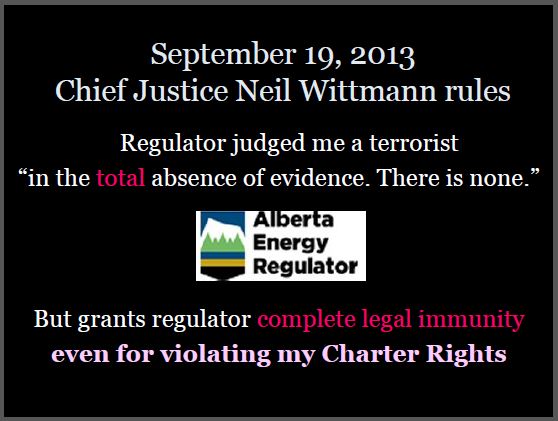
La demande d’autorisation d’appel est accueillie avec dépens selon l’issue de la cause.)
Coram: Abella / Karakatsanis / Côté
2015 01 11: Alberta courts stop publishing judgments to cut costs; Why not reduce the billions given to the oil and gas industry instead? [Some court links below may go nowhere. Time permitting, case judgements will be uploaded directly to the website.]
Que décidera la Cour Suprême? On saura après-demain si la Cour Suprême entendra l’appel de Jessica Ernst:
April 30, 2015, 9:45 AM (Ontario time), Ernst vs ERCB (now AER):
The Supreme Court of Canada will release their decision regarding Ernst’s leave application.
Press Release by Supreme Court of Canada / Cour suprême du Canada
(le français suit)
JUDGMENTS TO BE RENDERED IN LEAVE APPLICATIONS
April 27, 2015
For immediate release
OTTAWA – The Supreme Court of Canada announced today that judgment in the following applications for leave to appeal will be delivered at 9:45 a.m. EDT on Thursday, April 30, 2015. This list is subject to change.
PROCHAINS JUGEMENTS SUR DEMANDES D’AUTORISATION
Le 27 avril 2015
Pour diffusion immédiate
OTTAWA – La Cour suprême du Canada annonce que jugement sera rendu dans les demandes d’autorisation d’appel suivantes le jeudi 30 avril 2015, à 9 h 45 HAE. Cette liste est sujette à modifications.
…
7. Jessica Ernst v. Alberta Energy Regulator (Alta.) (Civil) (By Leave) (36167)
…
2014 03 31: PRESS RELEASE by Klippensteins (French Translation below):
ROSEBUD, AB, March 31, 2015 /CNW/ – Plaintiff Jessica Ernst is raising serious concerns regarding blatant, widespread and systemic deficiencies in Encana’s disclosure of records, including Encana’s failure to disclose key records in a landmark lawsuit against EnCana, Alberta Environment and the Energy Resources Conservation Board (now AER) regarding water contamination caused by hydraulic fracturing.
“To be frank, EnCana’s disclosure was embarrassingly pathetic – it was an incomplete, disorganized, error-laden, repetitive and insulting mess that wastes everyone’s time and money, including the Court’s,” said Jessica Ernst. “This is yet another example of the disrespect with which Encana treats regular Albertans, and a further indication of how difficult it is for individuals to stand up to large corporations in court.”
The blatantly deficient nature of the List of Records filed by EnCana will make it very difficult for the court to understand the case, and have the very real effect of causing considerable delay and increasing costs on all sides. According to the Foundational Rules of the Alberta Rules of Court, full disclosure of documents by parties named in a lawsuit “provide a means by which claims can be fairly and justly resolved in or by a court process in a timely and cost effective way.”
Most concerning are key documents that are missing from EnCana’s disclosure. In particular, Encana failed to disclose:
- records regarding hundreds of gas wells fractured in drinking water zones at Rosebud;
- the chemicals used by EnCana at hundreds of wells near Rosebud; and
- investigations into other contaminated water wells in the Rosebud Area.
Ms. Ernst’s lawyers have written to EnCana’s lawyers noting that in light of Encana’s “extraordinarily deficient disclosure,” the only reasonable solution is for EnCana to redo its disclosure of records. A copy of the letter outlining the severe and widespread deficiencies in detail can be found here.
SOURCE Klippensteins
For further information:
Klippensteins Barristers & Solicitors:
Murray Klippenstein / Cory Wanless, (416) 598-0288;
Jessica Ernst: 1-403-677-2074, email hidden; JavaScript is required
2015 03 27 Murray Klippenstein Letter to Maureen Killoran, Osler – Ernst v EnCana – Disclosure of Records:
2012 11 28: Power of Attorney Calgary managing partner for Osler Hoskin Harcourt, Maureen Killoran, lawyer representing Encana in the Ernst vs Encana lawsuit:
And, to be perfectly frank, when you do energy law, as I do, or corporate litigation, you’re not dealing with life and death situations and people whose lives have been turned upside down, plaintiffs who are weeping. It’s just about money. [Emphasis added]
Encana se moque de Jessica et du système judiciaire!
Communiqué de presse
Rosebud, Alberta – Le 31 mars 2015 – La plaignante Jessica Ernst soulève des préoccupations sérieuses au sujet des déficiences flagrantes, généralisées et systémiques dans la divulgation des dossiers de la part d’Encana, dont la divulgation de documents clés dans le cas de jurisprudence contre Encana, Alberta Environment et le Energy Resources Conservation Board (maintenant AER) au sujet de la contamination de l’eau causée par la fracturation hydraulique.
“Pour être bien honnête, la divulgation d’Encana est franchement pathétique – elle est incomplète, désorganisée, pleines d’erreurs, répétitive et un gâchis insultant qui fait perdre le temps et de l’argent à tout le monde, incluant la Cour,” dit Jessica Ernst. “C’est un autre bel exemple du manque de respect qu’a Encana pour tous les Albertains ordinaires, et une autre signe qui illustre comment c’est difficile pour les individus de tenir tête à de larges corporations devant la cour.”
La nature déficiente si évidente de la List of Records déposée par Encana rendra les choses très difficiles pour la cour de comprendre le dossier, et a comme effet très réel de causer des délais considérables et augmenter les coûts pour tous les partis. Selon le Foundational Rules of the Alberta Rules of Court, une entière divulgation de documents par les partis nommés dans un procès “fournit les moyens pour qu’un cas soit résolu de manière équitable et juste en ou selon un procès de cour en temps opportun et selon un rapport coût/efficacité raisonnable.”
Les plus préoccupants sont des documents clés manquant dans la divulgation d’Encana. Notamment, Encana n’a pas dévoilé:
- les documents au sujet des centaines de puits de gaz fracturés dans des zones d’eau potable de Rosebud;
- les produits chimiques utilisés par Encana dans des centaines de puits près de Rosebud; et
- les enquêtes faites sur d’autres puits d’eau potable contaminés dans la région de Rosebud.
Les avocats de Mme Ernst ont écrit aux avocats d’Encana que vu la “divulgation extraordinairement déficiente” d’Encana, la seule solution serait qu’Encana refasse sa divulgation de dossiers. Une copie de la lettre exposant les déficiences sévères et généralisées en détails peut être consultée ici.
Comment un travail si évident d’insuffisance professionnelle et de si grande portée peut même être considéré comme étant acceptable pour nous le faire parvenir est incompréhensible. Peut-être qu’il s’agit de normes de qualité de travail si faibles de la part de quiconque aurait effectué ou supervisé cette tâche, ou le mépris envers une Albertaine ordinaire qui ose défier la puissante Encana, ou un placement semi-délibéré d’un obstacle aux tentatives de Mme Ernst d’emmener cette question devant la cour, ou une indifférence cavalière envers l’entente que vous avez faite ou les besoins de la cour, ou une certaine combinaison de tout cela. Ce n’est pas facile de trouver une quelconque justification raisonnable pour la livraison d’une version si manifestement déficiente d’une partie importante de cette poursuite. Dans tous les cas, vu la nature, le nombre et la sévérité de ces déficiences, la seule solution doit être qu’Encana refasse sa divulgation de ses documents de façon à ce qu’elle se conforme au Alberta Rules of Court et le Protocol Regarding Electronic Discovery comme il avait été convenu.
Contacts:
Klippensteins Barristers & Solicitors:
Murray Klippenstein / Cory Wanless, (416) 598-0288;
Jessica Ernst: 1-403-677-2074, email hidden; JavaScript is required
Supreme Court of Canada Summary: Jessica Ernst v. Alberta Energy Regulator
Keywords Canadian charter (Non-criminal) – Constitutional law, Enforcement, Remedy, Freedom of expression (s. 2(b)).
Case summaries are prepared by the Office of the Registrar of the Supreme Court of Canada (Law Branch) for information purposes only.
Charter of Rights – Constitutional law – Enforcement – Remedy – Freedom of expression – Statutory immunity clause held to preclude adjudication of individual’s action in damages for alleged Charter breach by the regulator – Can a general “protection from action” clause contained within legislation bar a Charter claim for a personal remedy made pursuant to s. 24(1) of the Charter – Can legislation constrain what is considered to be a “just and appropriate” remedy under s. 24(1) of the Charter – Vancouver (City) v. Ward, 2010 SCC 27, [2010] 2 S.C.R. 28.
The applicant owns land near Rosebud, Alberta. She brought an action against: i) EnCana Corporation for damage to her water well and the Rosebud aquifer allegedly caused by its construction, drilling, hydraulic fracturing and other activities in the area; ii) Alberta Environment and Sustainable Resource Development, claiming it owes her a duty to protect her water supply and had failed to address her complaints about EnCana; and iii) the respondent regulator, for “negligent administration of a regulatory regime” related to her claims against EnCana. She brought a further claim for damages against the regulator under s. 24(1) of the Charter for alleged breaches of her s. 2(b) Charter rights. She alleges that from November, 2005 to March 2007, the Board’s Compliance Branch refused to accept further communications from her through the usual channels for public communication until she agreed to raise her concerns only with the Board and not publicly through the media or through communications with other citizens. She submits the respondent infringed her s. 2(b) Charter rights both by restricting her communication with it and by using those restrictions to punish her for past public criticisms and prevent her making future public criticisms of the respondent.
The respondent brought an application to strike paragraphs from the Statement of Claim or grant summary judgment in its favour. The Court of Queen’s Bench of Alberta granted the application and struck out the applicant’s negligence and Charter claims. While the Court held that the Charter claims were not doomed to fail and did disclose a cause of action, it held that the courts were precluded from considering the claims by the statutory immunity provision in the Energy Resources Conservation Act, R.S.A. 2000, c. E-10. The Alberta Court of Appeal dismissed the appeal.
36167 Jessica Ernst c. Alberta Energy Regulator
(Alb.) (Civile) (Sur autorisation)
Charte des droits – Droit constitutionnel – Exécution – Réparation – Liberté d’expression – Il a été jugé qu’une disposition législative accordant l’immunité empêchait de trancher une action en dommages-intérêts fondée sur une violation de la Charte censément commise par l’organisme de règlementation – Une disposition accordant une protection générale contre les actions prévue dans la loi rend-elle irrecevable une demande de réparation personnelle faite en application du par. 24(1) de la Charte ? – Une loi peut-elle restreindre ce qui est considéré comme une réparation « convenable et juste » au sens du par. 24(1) de la Charte ? – Vancouver (Ville) c. Ward, 2010 CSC 27, [2010] 2 R.C.S 28.
La demanderesse est propriétaire d’un bien-fonds à Rosebud (Alberta). Elle a intenté une action contre i) EnCana Corporation, pour des dommages à son puits d’eau et à l’aquifère de Rosebud, censément causés par les activités que l’entreprise exerce dans la région, notamment ses activités de construction, de forage et de fracturation hydraulique, ii) Alberta Environment and Sustainable Resource Development, alléguant que ce ministère avait envers elle une obligation de protéger son approvisionnement en eau et qu’il avait omis de donner suite à ses plaintes au sujet d’EnCana et iii) l’organisme de réglementation intimé, pour [traduction] « négligence dans l’administration d’un régime de réglementation » en lien avec ses réclamations contre EnCana. Elle a en outre présenté une demande en dommages-intérêts contre l’organisme de réglementation en application du par. 24(1) de la Charte pour de présumées atteintes aux droits que lui garantit l’al. 2b) de la Charte . Selon la demanderesse, de novembre 2005 à mars 2007, la Direction de la conformité de l’organisme intimé avait refusé d’accepter d’autres communications de sa part par les canaux habituels de communication publique jusqu’à ce qu’elle accepte de ne faire part de ses préoccupations qu’à l’organisme, et non publiquement par les médias ou par des communications avec d’autres citoyens. Elle prétend que l’intimé a porté atteinte aux droits que lui garantit l’al. 2b) de la Charte en restreignant ses communications avec l’organisme et en utilisant ces restrictions pour la punir de ses critiques antérieures et l’empêcher de formuler d’autres critiques publiques de l’intimé.
L’intimé a présenté une demande pour obtenir la radiation de certains paragraphes de la déclaration ou un jugement sommaire en sa faveur. La Cour du Banc de la Reine de l’Alberta a accueilli la demande et a radié les réclamations pour négligence et les réclamations fondées sur la Charte présentées par la demanderesse. Même si la Cour a statué que les réclamations fondées sur la Charte n’étaient pas vouées à l’échec et qu’elles révélaient effectivement une cause d’action, elle a statué que les tribunaux ne pouvaient connaître des réclamations en raison de la disposition législative accordant l’immunité, prévue dans l’Energy Resources Conservation Act, R.S.A. 2000, ch. E-10. La Cour d’appel de l’Alberta a rejeté l’appel.
19 septembre 2013: Cour du Banc de la Reine de l’Alberta (Juge Wittmann) 2013 ABQB 537
Décision accueillant la demande de l’intimé en radiation des réclamations en négligence portées contre lui; radiation ou rejet des réclamations de la demanderesse afin d’obtenir une réparation personnelle pour violation de la Charte
15 septembre 2014: Cour d’appel de l’Alberta (Calgary) (Juges Côté, Watson et Slatter)
2014 ABCA 285; 1301-0346-AC
Rejet de l’appel
13 novembre 2014: Cour suprême du Canada
Dépôt de la demande d’autorisation d’appel
February 9, 2015: Supreme Court of Canada Justice Rosalie Abella, Justice Andromache Karakatsanis and Justice Suzanne Côté to review Ernst’s application for leave (to decide if the court will hear her case).
2013 01 07: Osler Hoskin & Harcourt (National – 2012)
In Montréal, Suzanne Côté is trumpeted by several peers as being “very strong” in her commercial, insolvency, and securities practice. Côté is defending Université de Montréal, Vivendi Canada, and École Polytechnique de Montréal, and Hydro-Québec in a class action challenging pension plan and retiree benefit program amendments and calculations. … The firm is also recognized for its blossoming Calgary office, where a “noticeably younger” team of litigators attends to matters concerning Alberta’s flourishing oil and gas markets as well as technology providers, insurers and corporate officers. … In the energy litigation capacity, Maureen Killoran is also thought of by peers as “bright, strong, and capable.” Killoran’s clients include EnCana, which Killoran represents in several matters, including a public prosecution by the Federal Government for an alleged breach of the Canada Wildlife Act, as well as an action brought against the client by a landowner for alleged damages caused by fracking. [Emphasis added]
2014 11 27: Suzanne Côté is a partner and head of the Montréal litigation practice at Osler, Hoskin & Harcourt LLP – firm representing Encana in the Ernst vs Encana lawsuit.
2014 05 09: Ernst Argues Alberta’s Energy Regulator (AER) Not Immune to Charter [Encana’s Ex VP Gerard Protti is Chair of the AER]
… Ernst’s lawyer Murray Klippenstein argued yesterday that no government or province can legislate themselves out of the fundamental rights guaranteed by the Charter of Rights, on which Ernst’s claim is based. He called the Charter “the supreme law of the land.”
He argued that Ernst’s right to freedom of expression was breached in 2005 when the regulator sent her a letter accusing her of making “criminal threats.” It informed her that regulator staff had been told “to avoid any further contact” with Ernst.
A letter by Ernst seeking clarification on that decision and what basis it was made was refused by the board and returned unopened. …
In a taped conversation in June 2006 with ERCB lawyer Rick McKee, McKee said that “criminal threats” were never an issue, but that the board was upset with the landowner for airing her grievances in public and therefore embarrassing the regulator.*
“What you are doing is, hey, I don’t want to make it sound like people are a bunch of sensitive, you know, but at the end of the day, you are, you seem to be, attempting to humiliate the organization. And if that is your intention good on you, but don’t expect us to help you,” McKee told Ernst.
(The Tyee has heard the recording, read the transcripts and checked with actual witnesses. The incident is detailed in the original statement of claim.)
…
“Jessica is fighting for the welfare of the public in general,” said Shawn Campbell, a semi-retired 65-year-old rancher from Ponoka, Alberta. “To me, the issue is government transparency, and we have none of it. They’re in the deepest closet they can find.”
January 30, 2015: the Alberta Government filed their Statement of Defence:
34. Further, and in the alternative, if the Plaintiff did incur any loss or damages as
alleged in the statement of claim, or at all, which the Province does not admit but rather denies, then any such loss or damages were caused solely or substantially contributed to by the negligence of EnCana, for which the Province is not liable.
January 15, 2015, the Alberta Government suddenly announced it had other unexpected issues arise and was unable to file its Statement of Defence by mid-January, as promised in 2014.
“Triple costs” the court ordered the Alberta government to pay (works out to much less than what Ernst had to pay to fight Environment’s third and “improper” attack on the case):
Fees: $ 7,500.00
Disbursements: $ 230.10
Other Charges: $ 366.00
GST: $ 408.81
TOTAL: $ 8,500.91
(On January 20, 2015, the government, with banks full of cash they do not need to account for – according to AER’s lawyer Mr Glenn Solomon, finally paid Ernst these costs. The ruling was dated November 7, 2014)
COMPARE: So far, the court ordered (even though the case is clearly in the public interest) Ernst to pay industry, aka the ERCB (AER, 100% funded by industry, headed by Ex-Encana VP Gerard Protti) $21,840.79 for Mr. Solomon’s costs. Ernst paid as ordered to.
DOCKET: Supreme Court of Canada (SCC): Jessica Ernst v. Energy Resources Conservation Board
January 18, 2014: Jessica Ernst v AER (File No 36167 Supreme Court Canada, filed copy) Reply to ERCB Response for Leave to Appeal
December 5, 2014: ERCB response to Ernst Memorandum of Argument, SCC
November 13, 2014: Ernst vs ERCB Memorandum of Argument, SCC
Memorandum with supporting documents
PRESS ADVISORY
ROSEBUD, AB, Nov 10, 2014 /CNW/ – The Chief Justice of the Court of Queen’s Bench of Alberta has ruled that Alberta Environment can be sued for failing to properly investigate and remediate water contamination allegedly caused by Encana’s hydraulic fracturing activities near Rosebud, Alberta.
“This is a big victory for water and for all Albertans. The decision means that landowners can stand up and hold governments and regulators to account if they fail in their duty to properly investigate environmental contamination” said Rosebud resident and plaintiff Jessica Ernst.
Alberta Environment argued in court it didn’t owe a “private duty of care” to individual landowners when investigating causes of groundwater contamination that left wells so polluted with methane and other contaminants that the water could (and still can) be lit on fire. In other words, the regulator argued that individual landowners couldn’t try to hold government legally responsible for negligent investigations of environmental contamination, no matter how faulty. The Court disagreed. Chief Justice Wittmann ruled that “[w]hile this is a novel claim, I find there is a reasonable prospect Ernst will succeed in establishing that Alberta owed her a prima facie duty of care.”
In addition to ruling in favour of Ms. Ernst on all key points, Chief Justice Wittmann took the rare step of ordering the government to pay triple Ms. Ernst’s legal costs for the improper manner in which her claim was attacked.
“Ernst was wholly successful in responding to this Application. … These arguments could have been raised as part of Alberta’s first application, but were not. Ernst was put to the time and expense of two applications, not one. … As a result of these considerations Ernst shall have her costs against Alberta fixed at triple [the regular rate]”
SOURCE Klippensteins
For further information:
Jessica Ernst: (403) 677-2074, email hidden; JavaScript is required;
Klippensteins Barristers & Solicitors:
Murray Klippenstein, (416) 598-0288 or (416) 937-8634;
Cory Wanless, (416) 598-0288 or (647) 886-1914
Communiqué de presse
La cour statue qu’Alberta Environment peut se faire poursuivre pour n’avoir pas correctement enquêté une contamination de l’eau à Rosebud, en Alberta, et ne pas avoir pris des mesures d’assainissement.
Rosebud, Alberta (10 novembre 2014) – Le juge en chef de la Cour du Banc de la Reine en Alberta a statué qu’Environment Alberta peut se faire poursuivre pour ne pas avoir correctement fait enquête d’une contamination de l’eau, et ne pas avoir pris des mesures d’assainissement suite à une contamination présumément causée par des activités de fracturation hydraulique faites par Encana près de Rosebud, en Alberta.
On peut consulter le jugement ici
“Ceci est une grande victoire pour l’eau et pour tous les Albertains. La décision veut dire que les propriétaires terriens peuvent forcer les gouvernements et les régulateurs à prendre leurs responsabilités s’ils manquent à leurs obligations d’enquêter adéquatement les contaminations environnementales” dit la résidente de Rosebud et plaignante Jessica Ernst.
Environment Alberta soutenait en cour qu’il ne devait pas de “devoir privé de protection” envers les propriétaires terriens individuels lors d’enquêtes sur les causes de contaminations d’eau souterraine qui rendaient l’eau de puits si pollués avec du méthane et d’autres contaminants que l’on pouvait (et l’on peut encore) faire brûler l’eau. En d’autres mots, le régulateur soutenait que les propriétaires terriens individuels ne pouvaient pas essayer de rendre le gouvernement légalement responsable pour des enquêtes négligentes sur des contaminations environnementales, peut importe la gravité. La Cour n’est pas d’accord. Le juge en chef Wittmann a statué que “bien que ce soit une nouvelle réclamation, je crois qu’il y a une perspective raisonnable que Ernst réussira à établir que l’Alberta lui devait à première vue un devoir de protection.”
En plus de statuer en faveur de Mme Ernst sur tous les points-clés, fait rare, le juge en chef Wittmann a ordonné au gouvernement de payer les coûts légaux de Mme Ernst en triple pour la façon incorrecte qu’on a attaqué sa réclamation.
“Ernst a réussi complètement à répondre à cette Application…. Ces arguments auraient pu être soulevés lors de la première application, mais cela n’a pas été fait. On a obligé Ernst de prendre le temps et rencontrer les coûts de deux applications, pas seulement une….Suite à ces considérations, Ernst verra ses coûts contre l’Alberta triplés (du tarif régulier).”
Mr. Glenn Solomon invoices Ernst $15,750 costs re Alberta Court of Appeal denying Ernst v ERCB appeal October 10, 2014

Happy Thanks Giving, View from Ernst property October 10, 2014
Last Stop for High Profile Fracking Suit: Supreme Court, In striking Ernst appeal, Alberta court wraps blanket of immunity around regulator by Andrew Nikiforuk, September 16, 2014, TheTyee.ca
The Alberta Court of Appeal has effectively ruled that one of the nation’s most powerful regulators can violate the nation’s Charter of Rights and Freedoms by banishing citizens and falsely branding them as a security threats.
Alberta Court of Appeal rules that Alberta’s key energy regulator cannot be sued by citizens – even if it breaches constitutional rights
ROSEBUD, ALBERTA–(September 15, 2014) The Alberta Court of Appeal ruled today [Ruling later removed from Alberta Courts. Click here for the ruling] that Alberta’s key energy regulator cannot be sued by citizens – even if it breaches constitutional rights. In a judgment released today in a landmark lawsuit by Jessica Ernst against EnCana, Alberta Environment and the Energy Resources Conservation Board (ERCB, now AER) regarding water contamination caused by fracing, the Alberta Court of Appeal ruled that the Alberta government had granted complete and total legal immunity to Alberta’s key regulator, the ERCB, against all legal claims, including for violations of constitutional rights.
The Court also ruled that the ERCB does not owe any legally enforceable duties to protect individual landowners from the harmful effects of fracing, after the ERCB argued in court that it had total immunity for “not only negligence, but gross negligence, bad faith and even deliberate acts,” and therefore Albertans simply could not sue the ERCB, no matter how badly they were harmed by the ERCB’s acts or failures to act.
Ms. Ernst will seek leave to appeal the decision to the Supreme Court of Canada.
“I think Albertans will be disturbed to learn that their energy regulator has total and blanket legal immunity, even in cases where the regulator has breached the fundamental and constitutional free speech rights of a landowner,” said Murray Klippenstein, lead legal counsel for Ms. Ernst.
“I’ll be seeking leave to appeal this decision to the Supreme Court. These are critical issues that affect all Canadians,” said Jessica Ernst. “I will continue to fight for what’s right.”
The lawsuit against Alberta Environment and Encana continues.
Australian Petroleum Association: Coal seam damage to water inevitable by The Sydney Morning Herald, August 3, 2011.
The coal seam gas industry has conceded that extraction will inevitably contaminate aquifers. “Drilling will, to varying degrees, impact on adjoining aquifers,” said the spokesman, Ross Dunn. “The intent of saying that is to make it clear that we have never shied away from the fact that there will be impacts on aquifers,” Mr Dunn said.
Canadian Association of Petroleum Producers: Coal bed methane operations contaminate water resources by The Calgary Herald, August 28, 2014
Yet CAPP’s Alex Ferguson says many worries about water quality are based on past operations involving coal-bed methane — shallow deposits in closer proximity to groundwater. These did occasionally contaminate water resources, he says. In some of the more infamous instances, affected landowners could light their well water on fire.
Alex Ferguson was appointed Commissioner and CEO of the BC Oil and Gas Commission from 2007-2011
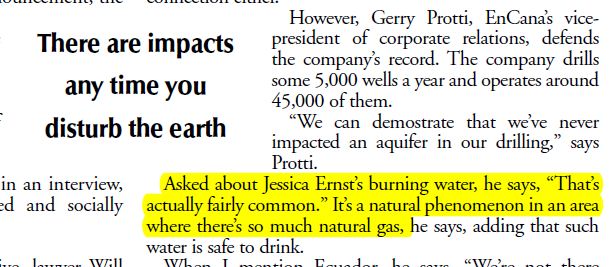
“That’s actually fairly common.”
EnCana VP, Mr. Gerard Protti (appointed Chair of the AER by the government in 2013) in a 2006 interview about Ernst’s water.
A Partial Time Tracker:
Four months and 2 week (18 weeks) since Court of Appeal of Alberta heard arguments on May 8, 2014 regarding the Court of Queen’s Bench granting the ERCB complete legal immunity, even for violating the Canadian Charter of Rights and Freedoms.
2012 Justice Barbara Veldhuis states – too much information; 2014 Court of Appeal of Alberta Justices state – not enough information:
April 2012: Justice Veldhuis requests a shorter Statement of Claim;
Klippenstein states in court that in his experience, courts will inevitably ask for more information. Ernst cooperates and fulfills the request for a shortened Claim.
May 2014: the Court of Appeal of Alberta Justices complain there wasn’t more information in the shortened Statement of Claim, and inquire about the ERCB’s Statement of Defence (to date, the ERCB has not filed one).
Seven months and one week (29 weeks) since Court of Queen’s Bench heard arguments in Drumheller on April 16, 2014 on Alberta Environment’s Motion to Strike (after 3 years of process already and their failed application to strike the word contamination and mention of other contaminated water wells at Rosebud), and the regulator’s secret editing of Dr. Alec (Alexander) Blyth’s “independent” report dismissing the contamination of Ernst’s well water.
Document exchange dates ordered: On April 16, 2014, Justice Wittmann requested document exchange between Ernst and Encana, saying there is no need to wait until the matters of the other defendants are ruled on. For months, Encana wouldn’t even agree to schedule a case management phone call. On July 14, 2014, Justice Wittmann ordered Ernst to give Encana her documents by October 31, 2014 and Encana to give Ernst its documents by December 19, 2014. Encana argued that it should not have to give any documents until the matters of the Alberta government and ERCB are resolved. August 2014, Encana finally agrees to cooperate with the document exchange protocol, accepting searchable, manageable, usable PDFs.
It took nearly 9 months (35 weeks) for Court of Queen’s Bench to rule on the January 18, 2013 hearing: ERCB motion to strike and Alberta Environment motion to remove the word contamination and mention of other contaminated water wells in Rosebud.
It took a year to set the first hearing on April 26, 2012, where Justice Veldhuis requested a shorter statement of claim. It took 7 months to set the January 18, 2013 hearing. It took another 7 months from Justice Wittmann’s September 19, 2013 ruling to get to the third hearing, on April 16, 2014.
It took 2 years and 4 months for Encana to file statement of defence.
The ERCB and Alberta Government did not file statements of defence.
It took 4 years to get the data from the Alberta Research Council (now Alberta Innovates) on the water contamination cases under Freedom of Information legislation, ordered released by OIP Commissioner’s Office after a year and half in inquiry. The public baseline water well testing data remains withheld even though it was ordered released to Ernst.
May 8, 2014, 10 AM: Appeal hearing Ernst vs ERCB (now AER) in Alberta Court of Appeal in Calgary: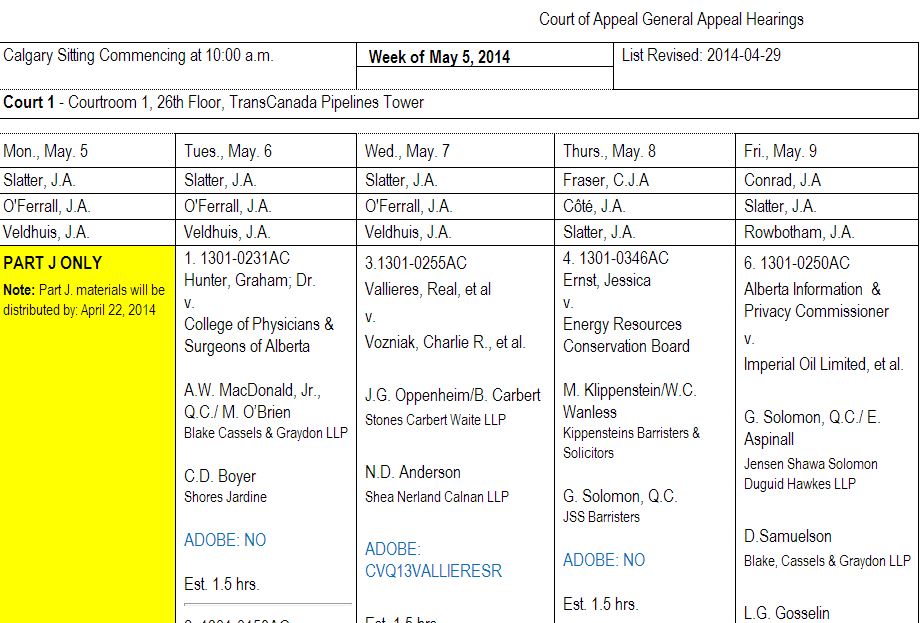
The ERCB’s (now AER) Response to Ernst’s Appeal Factum.
The ERCB (now AER) chose not to file a Notice of Cross Appeal but argues an additional and novel issue in direct opposition to the finding of Justice Wittmann, that Ernst’s Charter claim is not valid because, it is argued, the ERCB did not limit the Appellant’s right to free expression. This issue was not raised in the Notice of Appeal, the Appellant’s Factum or any Notice of Cross Appeal.
April 16, 2014: Alberta Minister of Justice and Solicitor General intervenes against Ernst in appeal of ERCB Charter violation
Court sketch, Ernst v. Alberta Government.
An Alberta government lawyer argued in court this week that Jessica Ernst’s lawsuit on hydraulic fracturing and groundwater contamination should be struck down on the grounds that it would open a floodgate of litigation against the province.
“There could be millions or billions of dollars worth of damages,” argued Crown counsel Neil Boyle.
Seven years ago, oil patch consultant Ernst sued Alberta Environment, the Energy Resources Conservation Board and Encana, one of Canada’s largest shale gas drillers, over the contamination of her well water and the failure of government authorities to properly investigate the contamination.
The $33-million lawsuit alleges that Encana was negligent in the fracking of shallow coal seams; that the ERCB breached Ernst’s freedoms under the Charter of Rights and Freedoms, and that Alberta Environment performed a problem-plagued investigation in bad faith.
The case, which effectively puts the performance of the province’s oil and gas regulators on trial, has drawn international attention.
The Alberta government made the application to strike the entire claim after Chief Justice Neil Wittmann ruled last fall that that lawsuit against Encana and Alberta Environment could proceed, but that the ERCB (now Alberta Energy Regulator) was exempt from civil action due to an immunity clause.
In Jan. 2013, Alberta Environment tried unsuccessfully to delete the word “contamination” as well as several clauses from the lawsuit that specifically mentioned other polluted water wells in central Alberta.
Courtroom drama
Justice Wittmann had trouble following the coherence of the government argument to strike the claim in the crowded Drumheller courtroom.
He noted that Boyle’s line of reasoning, which argued that the Crown owed no private duty of care to landowners, suggested that Alberta Environment would have to be negligent all the time before it could ever be found liable.
Boyle also argued that immunity clauses in the Environmental Protection and Enhancement Act and the Water Act shielded the province from any civil action. But questions from Wittman made it clear that these immunity clauses were not strong and only included actions taken “in good faith.”
Justice Wittmann also questioned Ernst’s lawyer Murray Klippenstein about the government’s filing of a report by the Alberta Research Council that dismissed Ernst’s water well case as insignificant. The government claimed the report was an independent review that proved there was no merit in the Ernst case.
Klippenstein argued that such a filing of evidence was inappropriate at this time. He also submitted a collection of Alberta Environment emails obtained through freedom of information legislation that he argued show the Alberta Research Council report was edited by Alberta Environment and not an independent review.
Justice Wittmann allowed the submissions in the event of an appeal.
ALBERTA REGULATOR’S SECRET EDITING EMAILS, PROVING THE ALBERTA RESEARCH COUNCIL REPORTS FRAUDULENT:
April 16, 2014: Drumheller Court of Queen’s Bench Hearing on the Alberta Government’s Application to strike out the Ernst case against them.
Duty of Care Chart presented by Klippensteins in the hearing:
2014 04 02: Reply Brief by Alberta government (Alberta Environment) to Jessica Ernst’s Brief of Argument in response to the government’s Application to Strike
17. … Similar to a criminal investigation, the province is obliged to provide information to the party being investigated (EnCana), so that this party may respond, but the complainant (similar to a victim in a crime), does not necessarily participate actively in the investigation or have any rights in this regard.
2014 01 18: Hearing Transcripts arguments on Applications to Strike by the Alberta Government (Alberta Environment) and ERCB (now AER) heard by Justice Barbara Veldhuis (promoted off the case by the Harper government on February 8, 2013; Alberta Court of Queen’s Bench Justice Neil Wittmann volunteered to take over).
March 18, 2014: Jessica Ernst responds to the Alberta Government’s Application to Strike:
The approach taken by Alberta Environment is an abuse of process; the present Application should be dismissed, and further, Alberta Environment should be sanctioned with an award of substantial indemnity costs. There is ample case law holding that, barring special circumstances, a party should be allowed only one chance to attack an opponent’s pleadings.
February 18, 2014: Alberta Government Brief filed for Application to Strike the Ernst case against the Crown, claiming no private duty of care, no proximity, and immunity. The Crown waited nearly three years to argue such and Justice Wittmann allowed it (case management phone call, January 13, 2014). The hearing is set for April 16, 2014 in Drumheller Court of Queen’s Bench.
February 3, 2014: Ernst’s Appeal Factum (Appeal Number 1301-0346AC) filed in the Alberta Court of Appeal in Calgary. Hearing set for May 8, 2014.
January 30, 2014: Alberta government files Application to strike out the Ernst case against the Crown.
January 13, 2014 Case management call: Justice Wittmann returned the case to where by law it belongs – in Drumheller Court.
December 19, 2013: Alberta Court of Appeal approved our proposed schedule with minor changes. The approved schedule is as follows:
January 17, 2014 – Appellant to file and serve Appeal Record
February 5, 2014 – Appellant to file and serve Appellant’s materials
March 24, 2014 – ERCB (name changed to AER) to file and serve the ERCB’s materials
May 8, 2014 – Hearing (Calgary)
December 10, 2013: Notice of Appeal to the Court of Appeal filed and served on the defendants.
October 9, 2013: PRESS ADVISORY Chief Justice rejects Alberta government’s attack on Rosebud water contamination case – but dismisses case against Alberta’s key energy regulator, the ERCB.
(French translation of advisory below)
The practice of hydraulic fracturing – injecting fluids (gases or liquids, sand and toxic chemicals) under high pressure to shatter deep and shallow rock to stimulate hydrocarbons to flow – has raised serious economic, political, legal, health and environmental issues around the world.
In a judgment recently released by the Alberta Court of Queen’s bench, Chief Justice Neil Wittmann ruled on the first skirmishes in a landmark multi-million dollar claim by Jessica Ernst against EnCana, Alberta Environment and the Energy Resources Conservation Board (ERCB) regarding water contamination caused by fraccing.
Key parts of the judgment include:
The court rejected the Government of Alberta’s attempt to attack portions of the lawsuit, thereby paving the way for the claim against the Government of Alberta to proceed.
Justice Wittmann agreed there were valid claims asserted against the ERCB for breaching Ms. Ernst’s fundamental and constitutional right to freedom of expression. The court also found “the ERCB cannot rely on its argument on the Weibo eco-terrorism claim, in the total absence of evidence. There is none.” However, the court found that the Alberta government had granted complete immunity to the ERCB for all legal claims, including for breaches of constitutional rights.
Chief Justice Wittmann ruled the ERCB does not owe any legally enforceable duties to protect individual landowners from the harmful effects of fraccing, after the ERCB argued in court it had total immunity for “not only negligence, but gross negligence, bad faith and even deliberate acts,” and therefore Albertans simply could not sue the ERCB, no matter how badly they were harmed by the ERCB’s acts. Ms. Ernst was ordered to pay the ERCB’s costs.
Ms. Ernst has instructed her legal counsel to appeal the decision to dismiss the lawsuit against the ERCB.
“I think Albertans will be disturbed to learn that their energy regulator has total and blanket immunity, even in cases where the regulator has breached the fundamental and constitutional free speech rights of a landowner,” said Murray Klippenstein, lead legal counsel for Ms. Ernst.
“It is very worrying that citizens are unable to hold the energy regulator accountable for failing to protect citizens from the harmful impacts of fraccing,” said Cory Wanless, co-counsel for Ms. Ernst. “If the energy regulator won’t protect citizens, who will?”
For more information, including Encana’s Statement of Defence, refer below:
-30-
CONTACT:
Klippensteins Barristers & Solicitors:
Murray Klippenstein
(416) 598-0288 or (416) 937-8634
Cory Wanless
(416) 598-0288 or (647) 886-1914
Jessica Ernst: 1-403-677-2074
email hidden; JavaScript is required
COMMUNIQUÉ DE PRESSE
Le juge en chef rejette l’attaque du gouvernement de l’Alberta dans le dossier de contamination de l’eau de Rosebud, mais écarte l’action contre le ERCB, le régulateur énergétique principal de l’Alberta.
La pratique de la fracturation hydraulique, qui consiste à injecter des fluides ( des gaz ou des liquides, du sable et des produits chimiques toxiques) sous haute pression afin de fissurer le roc profond et en surface afin de stimuler les hydrocarbures pour qu’ils se libèrent, a soulevé de sérieux questionnements économiques, politiques, légaux, environnementaux et sanitaires partout sur la planète.
Dans une décision judiciaire rendue dernièrement par la cour du banc de la Reine en Alberta, le juge en chef Neil Wittmann a statué sur les premiers accrochages dans une réclamation clé de plusieurs millions de dollars enclanchée par Jessica Ernst contre EnCana, Alberta Environment et l’agence Energy Resources Conservation Board (ERCB), au sujet d’une contamination de l’eau causée par le fracking.
Les éléments principaux du procès sont:
La cour a rejeté la tentative du Gouvernement de l’Alberta d’attaquer des parties du procès, ainsi ouvrant la porte à la réclamation contre le Gouvernement de l’Alberta pour qu’elle se poursuive.
Le Juge Wittmann convient qu’il y a des réclamations valides contre le ERCB pour avoir enfreint aux droits fondamentaux et constitutionnels de liberté d’expression de Mme Ernst. La cour a aussi conclu que “le ERCB ne peut pas se fier sur son argumentaire dans sa réclamation d’écoterrorisme à la Weibo, à cause de l’absence totale de preuves. Il n’y en a pas.” Toutefois, la cour a constaté que le gouvernement de l’Alberta a accordé une immunité complète à l’agence ERCB de toute réclamation légale, incluant des violations aux droits constitutionnels.
Le juge en chef Wittmann a statué que le ERCB n’a pas de devoirs légalement imposables pour protéger les propriétaires terriens individuels des impacts nuisibles du fracking, après que le ERCB ait argumenté à la cour qu’il bénéficiait d’une immunité totale pour “non seulement de la négligence, mais de la négligence grave, de la mauvaise foi et même des actes délibérés,” et donc les Albertains ne peuvent simplement pas poursuivre le ERCB, peu importe l’importance des dommages encourus à cause des gestes du ERCB. Mme Ernst a reçu les ordres de payer les coûts du ERCB.
Mme Ernst a demandé à ses avocats d’aller en appel de la décision de rejeter le procès contre le ERCB.
“Je crois que les Albertains seront troublés d’apprendre que leur régulateur énergétique jouit d’une immunité totale et générale, même dans des cas où le régulateur a enfreint aux droits fondamentaux et constitutionnels d’un propriétaire terrien,” dit Murray Klippenstein, le conseiller juridique principal de Mme Ernst.
“C’est très préoccupant de constater que les citoyens sont incapables de forcer le régulateur énergétique de rendre des comptes pour avoir manqué à la protection des citoyens contre les impacts nocifs du fracking,” dit Cory Wanless, coconseil de Mme Ernst. “Si le régulateur énergétique ne veut pas protéger les citoyens, qui le fera?”
Pour plus d’information, dont la requête de défense d’Encana: https://ernstversusencana.ca/the-lawsuit
-30-
CONTACTS:
Klippensteins Barristers & Solicitors:
Murray Klippenstein
(416) 598-0288 ou (416) 937-8634
Cory Wanless
(416) 598-0288 ou (647) 886-1914
Jessica Ernst: 1-403-677-2074
email hidden; JavaScript is required
September 16, 2013 Ernst files reply to Encana’s Statement of Defence
August 19, 2013: Encana files Statement of Defence
Encana did not file their Statement of Defence by June 15, 2013 as promised because “a few of their key people are on vacation.”
Mid-May, 2013, Encana promised to file their statement of defence no later than June 15, 2013.
On an April 15, 2013 case management call, Chief Justice Wittmann introduced himself to the parties, advised that he will rule on the January 18, 2013 hearing (heard by Judge Veldhuis) by reading the filed briefs and transcripts, may request a hearing if he has questions, and asked EnCana if there was any reason why the company couldn’t file their statement of defence. Encana failed to come up with a good reason, so they agreed to file it right away.
On a February 20, 2013 case management call, it was decided that Chief Justice Wittmann will choose whether to read the transcripts of the arguments heard by Justice Veldhuis on January 18 and rule, or require a re-hearing which will add significant delay and costs.
On February 8, 2013, the Harper Government promoted Justice Barbara L. Veldhuis to the Court of Appeal of Alberta; she will not rule on the defendants’ applications she heard in Court of Queen’s Bench on January 18, 2013. Court of Queen’s Bench Chief Justice Neil Wittmann volunteered to take over case management.
Ernst Statement to the Calgary Court of Queen’s Bench, read by Murray Klippenstein, January 18, 2013, heard by Justice Barbara L. Veldhuis:
I wanted to attend today’s hearing, but I decided not to attend because I feel strongly that my lawsuit should be heard in the judicial district of Drumheller as it is the courthouse with the closest connection to my dispute. This is where I live; this is where my water is; this is where coalbed methane wells were drilled; and this is where my water is contaminated. It seems to me that it is important to rural Albertans that disputes and harms that occur in our communities are also judged in our communities. Today’s application is not a minor or merely procedural step – it will determine the core issue of whether a landowner can sue the Energy Regulator for failing to protect rural Albertans from the harmful effects of the oil and gas industry.
I have a lot of respect for the court, and because of this respect, I feel it is important to make my position known. I will continue to request that all major applications be heard in Drumheller with the closest connection to my dispute.
Jessica at Drumheller Court, 10 AM, January 18, 2013. Jessica spent the day there, with a witness. Video of the hearing in Calgary Court was not available, requested or the heart of the matter.
On January 18, 2013, in Calgary Court of Queen’s Bench, Judge B. L. Veldhuis heard the defendants’ applications.
Ernst’s original amended Statement of Claim was filed in Drumheller Court April 21, 2011; Ernst’s unamended Statement of Claim was first filed in Drumheller Court December 3, 2007.
In the summer of 2011, Encana suggests that the case be moved to Calgary. Klippensteins respond by explaining to all defendants why it is best to proceed in the Drumheller judicial centre, which is where the harm took place.
On April 26, 2012, the first hearing took place in Drumheller Court. Rather than hear the defendants’ arguments to strike out the case, Judge Veldhuis requests a shortened statement of claim.
Read the Fresh Statement of Claim filed in Drumheller Court on June 25, 2012.
On October 1, 2012, during a case management call heard by Justice B.L. Veldhuis, Encana, the ERCB and Alberta Environment (HMQ) request the case be moved to Calgary for the convenience of the defendants’ lawyers despite the fact that Drumheller is clearly the court with the closest connections to the lawsuit.
Alberta Environment (HMQ): “It clearly tips in favour of the defendants’ position, that it ought to be in Calgary and not in Drumheller”
Encana’s Drumheller Office
Subsequently, the request to move this particular hearing to Calgary is granted by Judge Veldhuis and Alberta’s Chief Justice. The Plaintiff respectfully requests that all major applications be heard in Drumheller as it is the judicial district where the harm took place.
Read the ERCB’s Brief of Argument to strike the case against them, filed in Drumheller Court December 5, 2012.
Read Alberta Environment’s (HMQ’s) Brief of Argument on the Special Application to strike paragraphs referring to the other contaminated water wells in the Rosebud community and the word contamination, filed in Drumheller Court on December 5, 2012.
Encana did not file application to strike the case against them or any paragraphs, and argued nothing in court.
Read the Plaintiff’s Brief in Response to the ERCB, filed in Drumheller Court on December 21, 2012.
Read the Plaintiff’s Brief in Response to Alberta Environment (HMQ), filed in Drumheller Court on December 21, 2012.
Read the ERCB’s Reply Brief and Alberta Environment’s (HMQ’s) Reply Brief, filed in Drumheller Court on January 3, 2013.
December 15, 2012 – Encana frac’ing above the Base of Groundwater Protection at Rosebud, Alberta
Landmark Alberta Fracking Lawsuit Resumes in Calgary Court
Alberta’s Key Regulator Argues It Has No Duty of Care to Landowners and Groundwater
Friday Jan. 18 at Court of Queen’s Bench
Suite 705-N, 601 – 5th St SW, Calgary T2P 5P7
10 AM to 4 PM
Jessica Ernst, a 55-year-old oil and gas industry consultant and scientist from Rosebud, Alberta, returns to court this Friday to continue her multi-million dollar lawsuit against EnCana, one of the continent’s largest unconventional gas producers, for negligence causing water contamination.
Her landmark lawsuit also alleges that the Alberta Energy Resources Conservation Board (ERCB), the province’s energy regulator, breached her Charter Rights and failed to “exercise a reasonable standard of care, skill and diligence in taking reasonable and adequate steps to protect her well water from foreseeable contamination caused by drilling for shallow methane gas.”
Recent Court of Appeal decisions show the ERCB has a history of not upholding its own laws and even the Royal Society of Canada chided the agency for a 2007 incident in which the regulator spied on landowners and damaged “its credibility as an independent quasi-judicial board.”
In a court document filed on December 5/2012, the ERCB argues that it is exempt from liability for its actions in the Ernst case and that it owes no “duty of care” to landowners impacted by oil and gas development.
“I suspect that most Albertans will be shocked to learn that the province’s oil and gas regulator is arguing that it is totally immune from legal accountability even if there is gross negligence and incompetence,” says Murray Klippenstein, lawyer for Jessica Ernst.
Last December, an ERCB investigation found a company guilty of “accidentally” perforating above the Base of Groundwater Protection and contaminating groundwater near Grand Prairie but issued no fine saying the incident “posed an insignificant risk to drinking water resources” in a sandstone aquifer. One third of Alberta’s population is dependent on groundwater for drinking purposes.
During the last decade, EnCana intentionally perforated and fractured hundreds of gas wells above the Base of Groundwater Protection at Rosebud. The regulators continue to allow EnCana to do this.
In December 2012, only after about 171,000 energy wells were already fractured in Alberta, did the ERCB release draft regulations. Public input closes the day of this hearing on January 18, 2013.
The $33-million lawsuit effectively puts on trial the practice and regulation of hydraulic fracturing: the controversial blasting of both shallow and deep coal, tight sands, oil and shale formations with toxic chemicals, sand and water.
The poorly studied technology, which can cause earthquakes and methane leaks, has sparked moratoriums, bans, debates and regulatory investigations from New Brunswick to South Africa due to growing concerns about groundwater contamination, property devaluation, air pollution, health impacts and climate change.
Neither EnCana nor the Alberta regulators have yet filed statements of defense on incidents that took place nine years ago that resulted in scores of groundwater complaints.
EnCana, whose CEO abruptly resigned last week, has been the subject of many recent public controversies. It remains the subject of a major US government groundwater study in Pavillion, Wyoming linking hydraulic fracturing to aquifer contamination as well as an ongoing antitrust investigation in Michigan for allegedly colluding with Chesapeake Energy to keep land prices low. A grassroots organization of mothers has also challenged the company’s aggressive fracing operations in Colorado.
EnCana received record fines from Colorado’s Oil and Gas Commission for contaminating water in 2004.
Murray Klippenstein: 1-416-937-8634
Jessica Ernst: 1-403-677-2074 (cell: 403-436-2062) email hidden; JavaScript is required
Background
A 2008 scientific review panel report for Alberta Environment warned that “preliminary data from the Rosebud, Alberta area suggest groundwater gas concentrations are being underestimated by a factor of three.”
A 2008 presentation to the International Wellbore Intergrity Network in Paris, France, co-authored by the ERCB, admitted “high pressure fracturing” increased the potential to create pathways to groundwater, and “the likelihood that gas, due to migration through shallow zones, can accumulate in buildings.”
A 2009 paper also co-authored by the ERCB on gas migration being a chronic problem reports that “high buildup pressures may potentially force gas into underground water aquifers” and that the factors affecting gas leakage and migration “can be generalized and applied to other basins and/or jurisdictions.”
Procès marquant reprend à la cour de Calgary, en Alberta
Un régulateur clé de l’Alberta prétend qu’il n’a pas le devoir de protection envers les propriétaires terriens et l’eau souterraine
Vendredi le 18 janvier à la Cour du Banc de la Reine
Suite 705–N, 601 – 5e Rue SO, Calgary T2P 5P7
10:00 heures à 16:00 heures
Jessica Ernst, une consultante pour l’industrie pétrolière et gazière et scientifique de Rosebud en Alberta, âgée de 55 ans, revient devant le tribunal ce vendredi pour continuer son procès de plusieurs millions de dollars contre EnCana, l’un des plus important producteurs de gaz non conventionnel du continent, à cause de négligence qui aurait causé de la contamination de l’eau.
Son procès important prétend aussi que la commission Energy Resources Conservation Board (ERCB) de l’Alberta, le régulateur de l’énergie de la province, aurait violé sa Charte de Droits et aurait manqué à son devoir “d’exercer une norme raisonnable de protection, compétences et diligence en prenant des mesures raisonnables et adéquates pour protéger son eau de puits de la contamination prévisible causée en forant à la recherche de gaz de méthane peu profond.”
Des décisions récentes de la cour d’appel démontrent que la ERCB a une historique de ne pas faire respecter ses propres lois et même la Société royale du Canada a réprimandé l’agence pour un incident de 2007 durant lequel le régulateur a espionné sur des propriétaires terriens et nuit à “sa crédibilité en tant qu’une commission indépendante quasi judiciaire.”
Dans un document de la cour déposé le 5 décembre 2012, la ERCB soutient qu’elle est exemptée de toute responsabilité de ses actions dans la cause Ernst et n’a pas “le devoir de protection” envers les propriétaires terriens impactés par le développement pétrolier et gazier.
“Je pense que la plupart des Albertains seraient choqués d’apprendre que le régulateur de la province argumente qu’il est complètement exonéré de toute responsabilité légale même s’il y a eu extrême négligence et incompétence,” dit Murray Klippenstein, l’avocat de Jessica Ernst.
En décembre dernier, une enquête de la ERCB a déclaré une compagnie coupable d’avoir “accidentellement” perforé au-dessus de la base de protection de l’eau souterraine et avait contaminé l’eau souterraine près de Grand Prairie mais n’a émis aucune amende, disant que l’incident “ne posait pas de risque important à la ressource d’eau potable” dans un aquifère de formation de grès. Un tiers de la population de l’Alberta dépend de l’eau souterraine pour son eau potable.
Pendant la dernière décennie, EnCana a intentionnellement perforé et fracturé des centaines de puits de gaz bien au-dessus de la bas de protection de l’eau souterraine à Rosebud. Les régulateurs continuent de permettre Encana de le faire.
En décembre 2012, une fois qu’environ 171,000 puits énergétiques avaient déjà été fracturés en Alberta, et seulement à ce moment-là, la ERCB a émit son ébauche de règlements. La période pour recevoir les commentaires du public termine en cette journée de séance le 18 janvier 2013.
En réalité, le procès de $33 millions met en cause la pratique et les règlements encadrant la fracturation hydraulique: le dynamitage controversé des formations de charbon, qu’elles soient à faible profondeur ou très creuses, des réservoirs étanches dans le sable ou le schiste, des formations contenant du pétrole ou du gaz, avec des produits chimiques toxiques, du sable et de l’eau.
La technologie, si peu étudiée, qui peut provoquer des séismes et des fuites de méthane, a déclenché des moratoires, des interdictions, des débats et des enquêtes régulatrices du Nouveau-Brunswick jusqu’en Afrique du Sud à cause des préoccupations grandissantes pour les contaminations de l’eau souterraine, les dévaluations des propriétés, la pollution de l’air, les impacts sur la santé et les changements climatiques.
Ni EnCana, ni les régulateurs de l’Alberta n’ont encore déposé des requêtes pour la défense à propos des incidents qui ont eu lieu il y a de cela 9 ans maintenant et qui sont la source de plusieurs plaintes de problèmes d’eau souterraine.
EnCana, dont le PDG a brusquement démissionné la semaine dernière, a été au coeur de plusieurs controverses publiques récemment. La compagnie est toujours impliquée dans une étude gouvernementale sur l’eau souterraine aux États-Unis à Pavillion, au Wyoming, qui fait des liens entre la fracturation hydraulique aux contaminations de l’aquifère ainsi qu’avec une enquête antitrust toujours en cour au Michigan pour une présumée collusion avec Chesapeake Energy afin de garder les valeurs des terres à la baisse. Un groupe populaire de mères a aussi mis au défi les opérations agressives de la compagnie au Colorado.
EnCana a reçu amendes qui ont battu des record de la Commission pétrolière et gazière du Colorado pour avoir contaminé l’eau en 2004.
Murray Klippenstein: 1-416-937-8634
Jessica Ernst: 1-403-677-2074 (cell: 403-436-2062) email hidden; JavaScript is required
Mise en contexte
Un rapport de 2008 d’un comité de révision scientifique pour Environnement Alberta prévenait que les “données préliminaires venant de Rosebud, en Alberta, laissait penser que les concentrations de gaz dans l’eau souterraine sont sous-estimées par un facteur de trois.”
Une présentation au groupe International Wellbore Intergrity Network en 2008 à Paris, France, dont la ERCB était un coauteur, admettait que la “fracturation à haute pression” augmentait le potentiel de créer des passages vers l’eau souterraine, et “la probabilité que le gaz, à cause de la migration à travers les zones peu profondes, peut s’accumuler dans les bâtiments.”
Un papier dont ERCB est aussi un co-auteur datant de 2009 sur la migration du gaz étant un problème chronique rapporte que “l’accumulation importante de la pression peut potentiellement forcer le gaz à pénétrer dans les aquifères d’eau souterraine” et que les facteurs affectant les fuites de gaz et la migration “peuvent être généralisés et s’appliquer à d’autres basins et/ou d’autres juridictions.”
January 17, 2013, Bob Curran, Public Affairs Section Leader, ERCB, on GlobalTV:
“We evolve the regulations on an ongoing basis to ensure that they’re protective of groundwater and public safety and that waste is disposed of properly as well.”
April 19, 2011, Darin Barter, ERCB spokesman, to the Peace River Record Gazette:
The ERCB does not test drilling waste before it is deposited on fields, said Barter, nor will it inspect deposits unless contacted by the landowner, as staff is limited, and the practice is common. “It is the company’s responsibility to follow the rules. We can’t be there in every location throughout the province every time something is done”
2007, Darin Barter, ERCB spokesman:
“If they are not following our regulations, we should be involved in it.”
The report also found that a variety of products — including hazardous materials and lubricants — had been discarded or abandoned “with no apparent concern for the environment.”
“A lack of responsibility and supervision are evident at other sites, wherein examples of poor industry practices and lackadaisical housekeeping abound”
In the report, base commander Lt.-Col. Dan Drew said the base is not prepared to accept “such substandard performance from the oil and gas industry.
“These incidents appear to run counter to industry guidelines and standard practices, and illustrate an apparent lack of respect for the landowner and the lands themselves,” Drew wrote in a prefacing letter dated Feb. 8, 2006.
“The base is not prepared to tolerate these types of destructive and negligent operating practices,” added Drew.
2007: Suffield Files Reveal Disturbing Story of Environmental Degradation, Non-compliance by Energy Companies and Industry Giant EnCana
2006 CAPP’s Best Management [Voluntary] Practices for NGC/CBM:
“Drilling fluids are transported, stored and handled in tanks. Typically, drilling fluid waste will be transported off-site for re-use and treatment/disposal…. Some additives may be caustic, toxic, or acidic.”
Or, they’re mass dumped on pasture and cropland like Encana (now Ovintiv) did at Rosebud, and in many other communities, enabled by AER/ERCB/EUB while CAPP lies on:

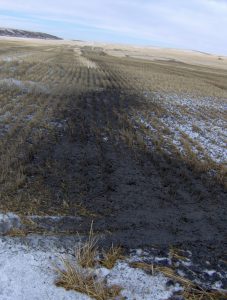
2003: Alberta Landspraying While Drilling (LWD) Review by Alberta Sustainable Resource Development, released three years later, only after FOIP and public pressure.

